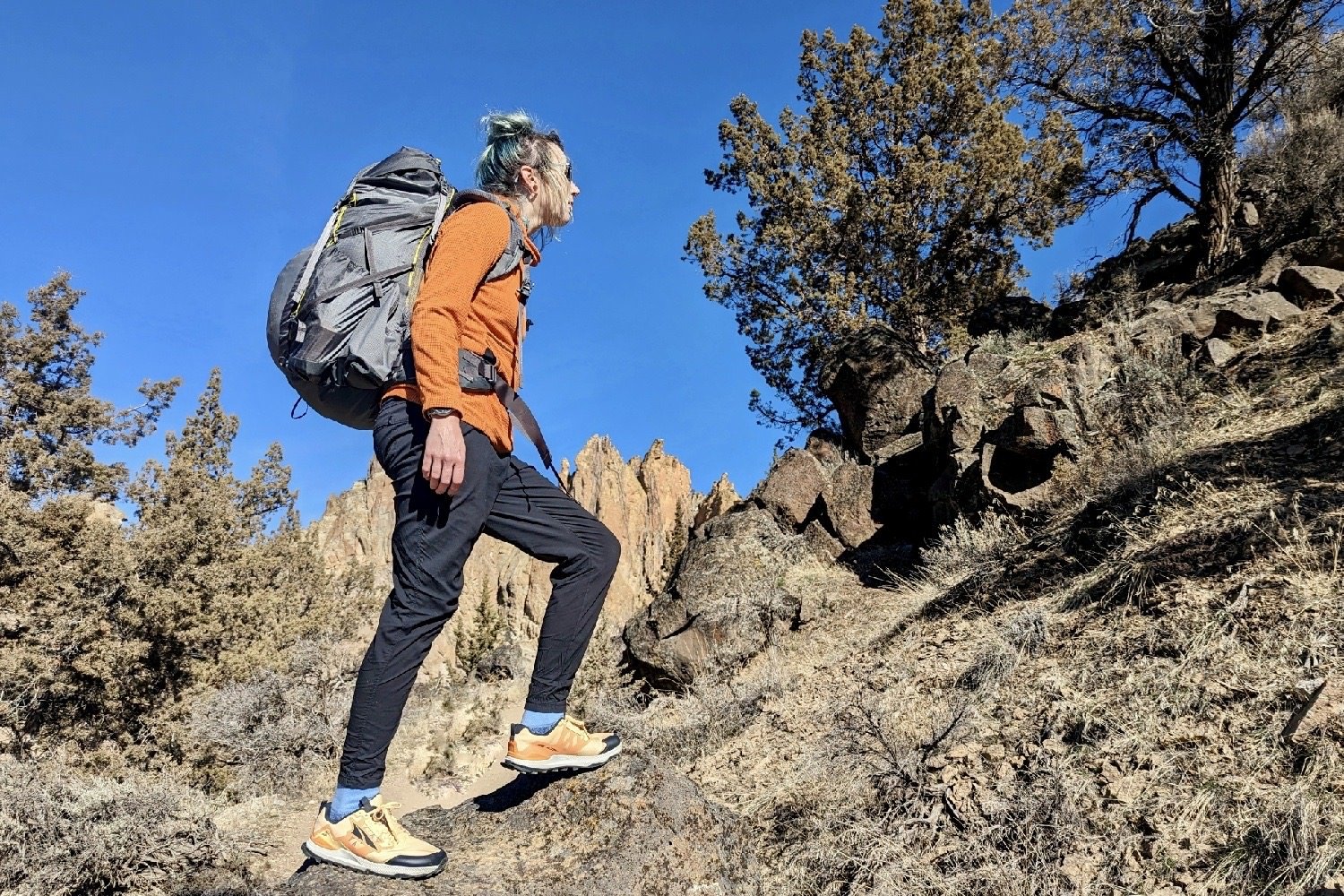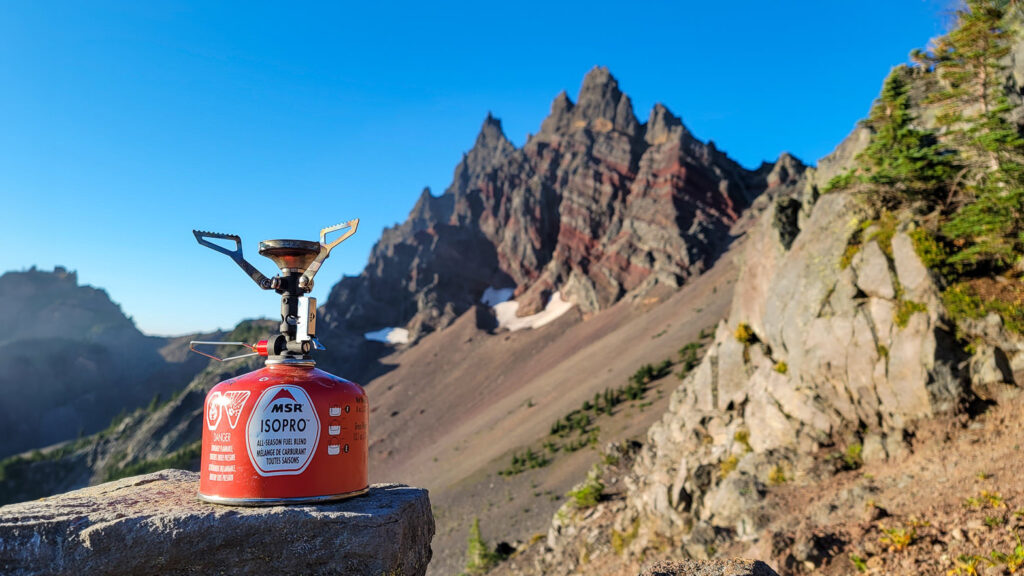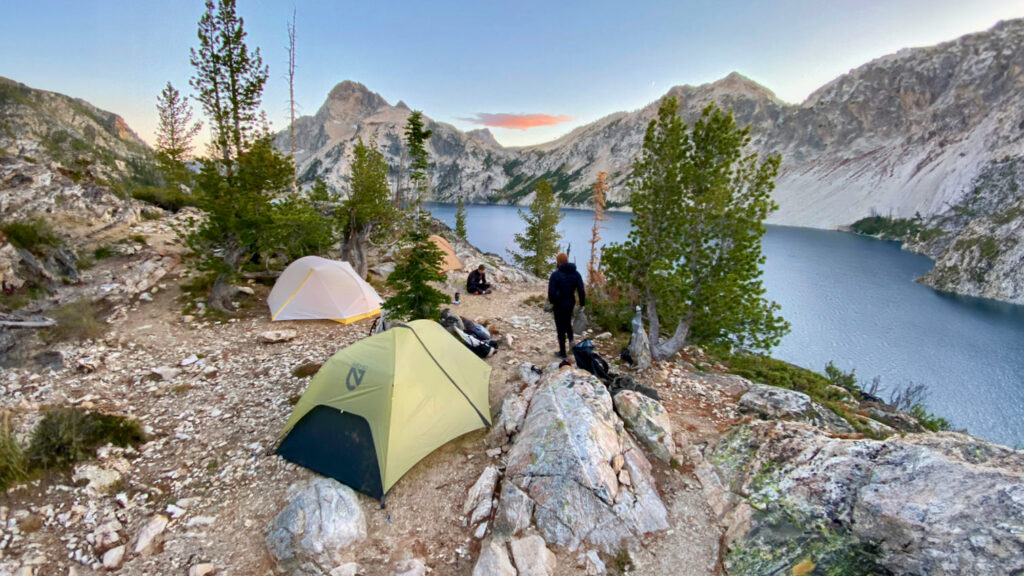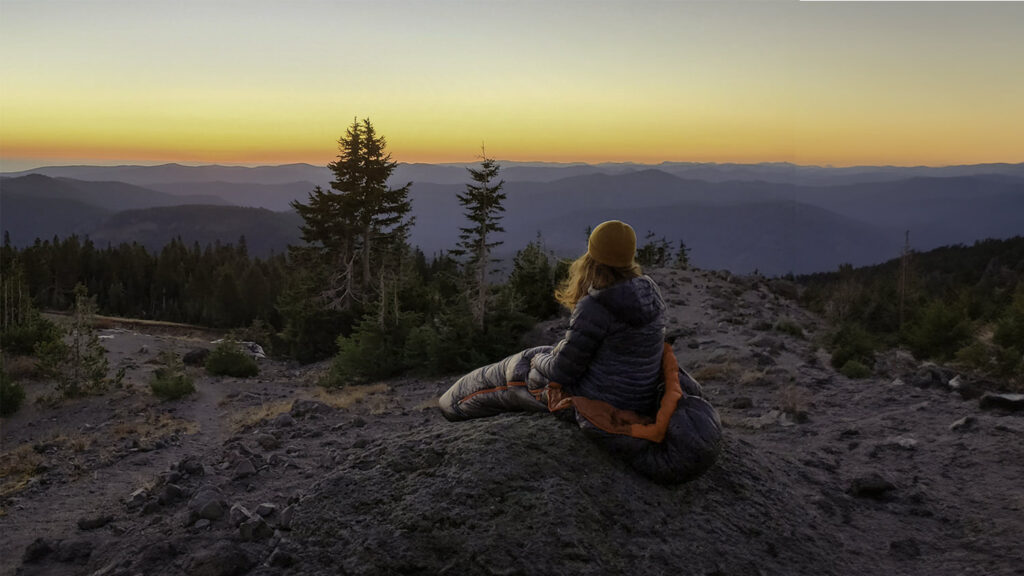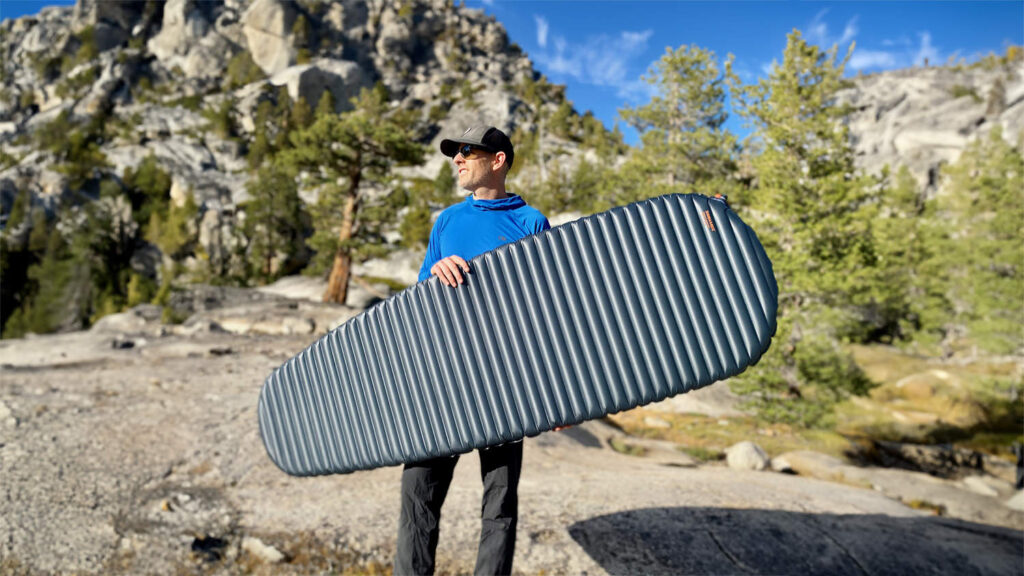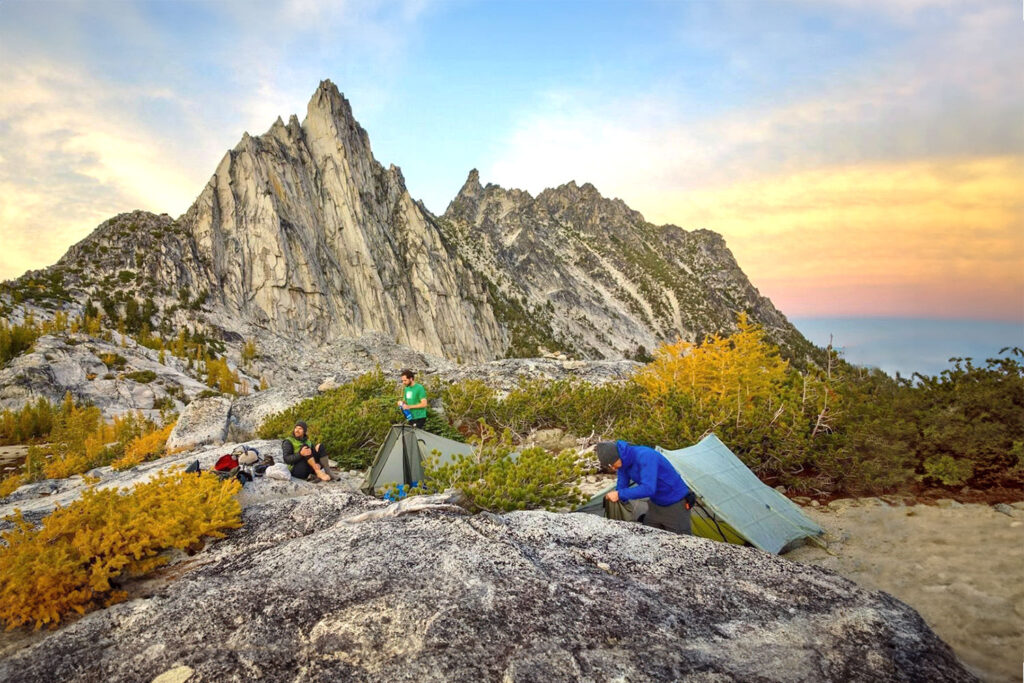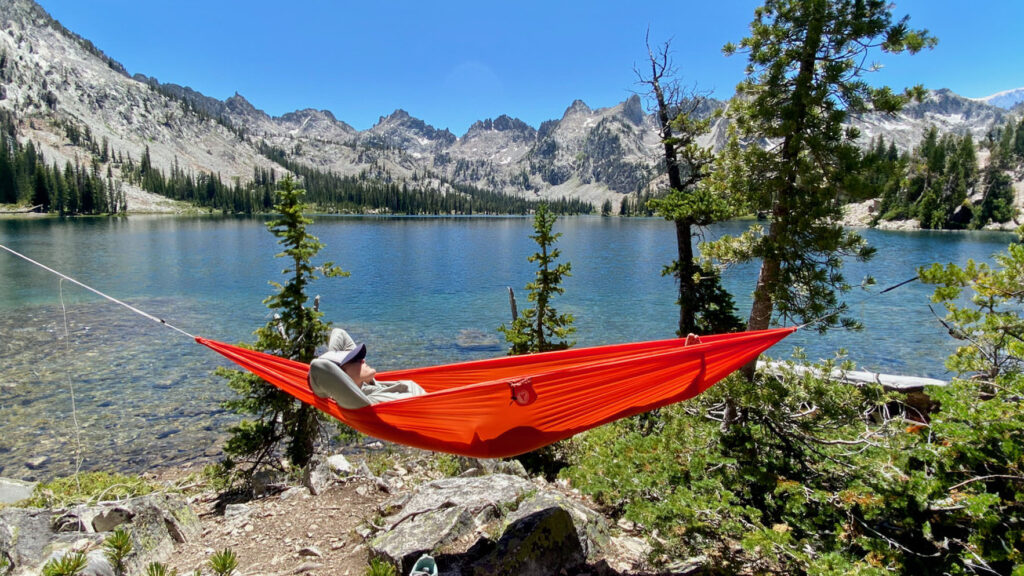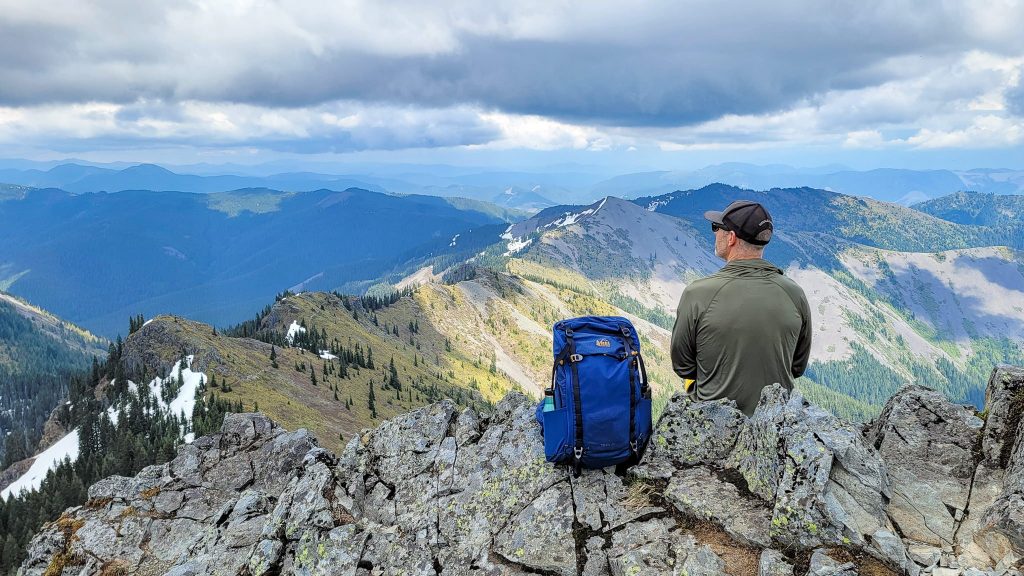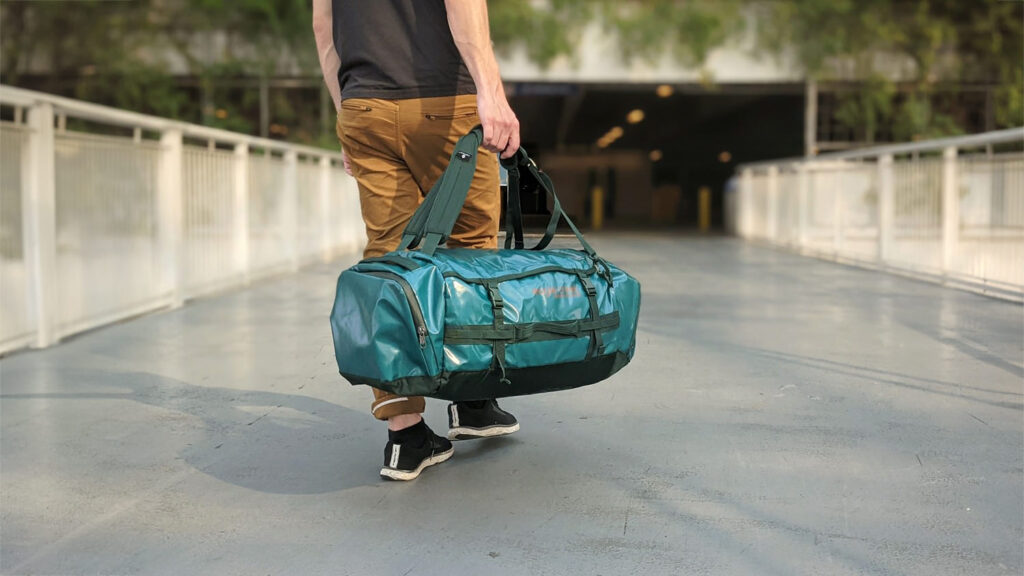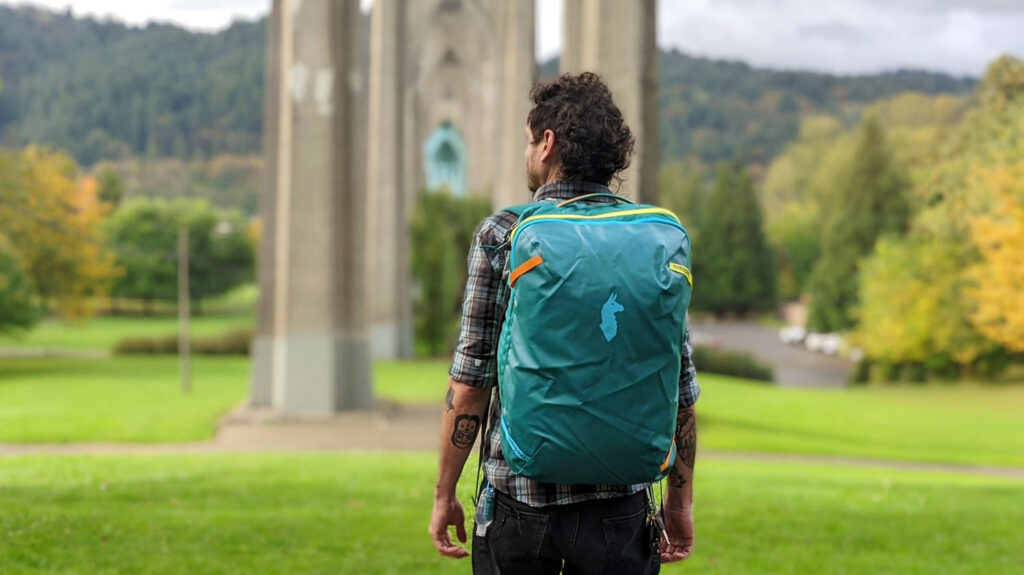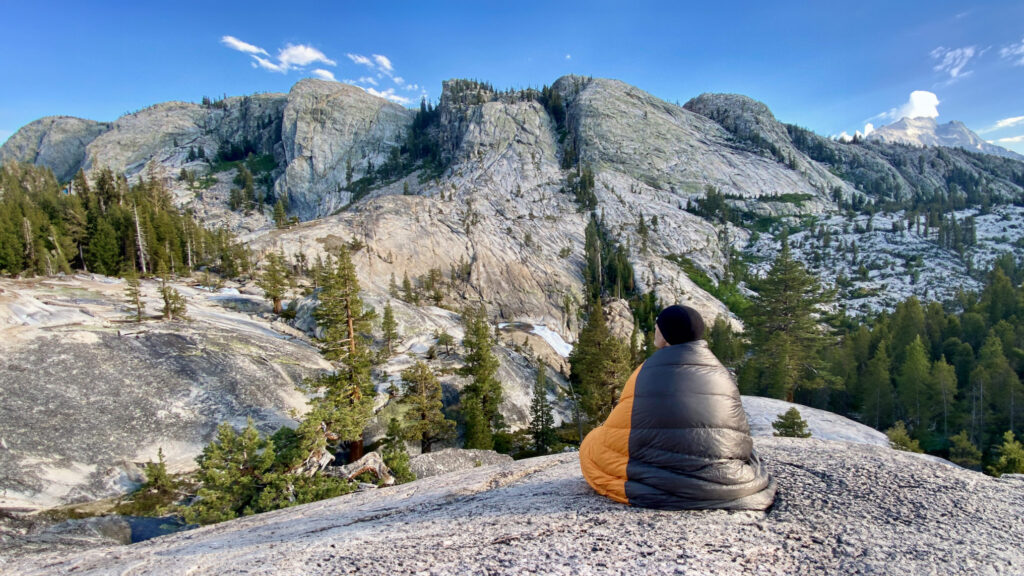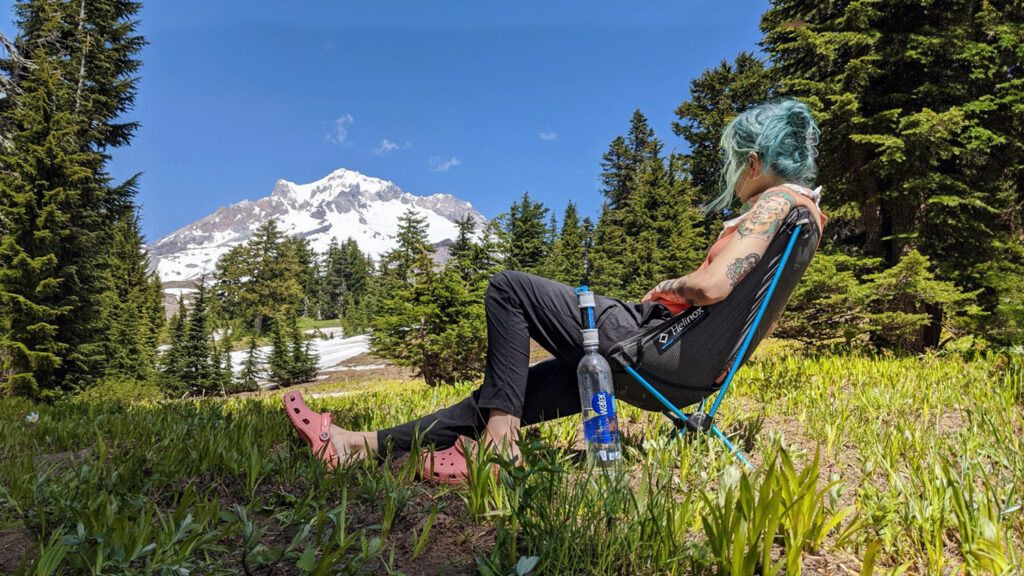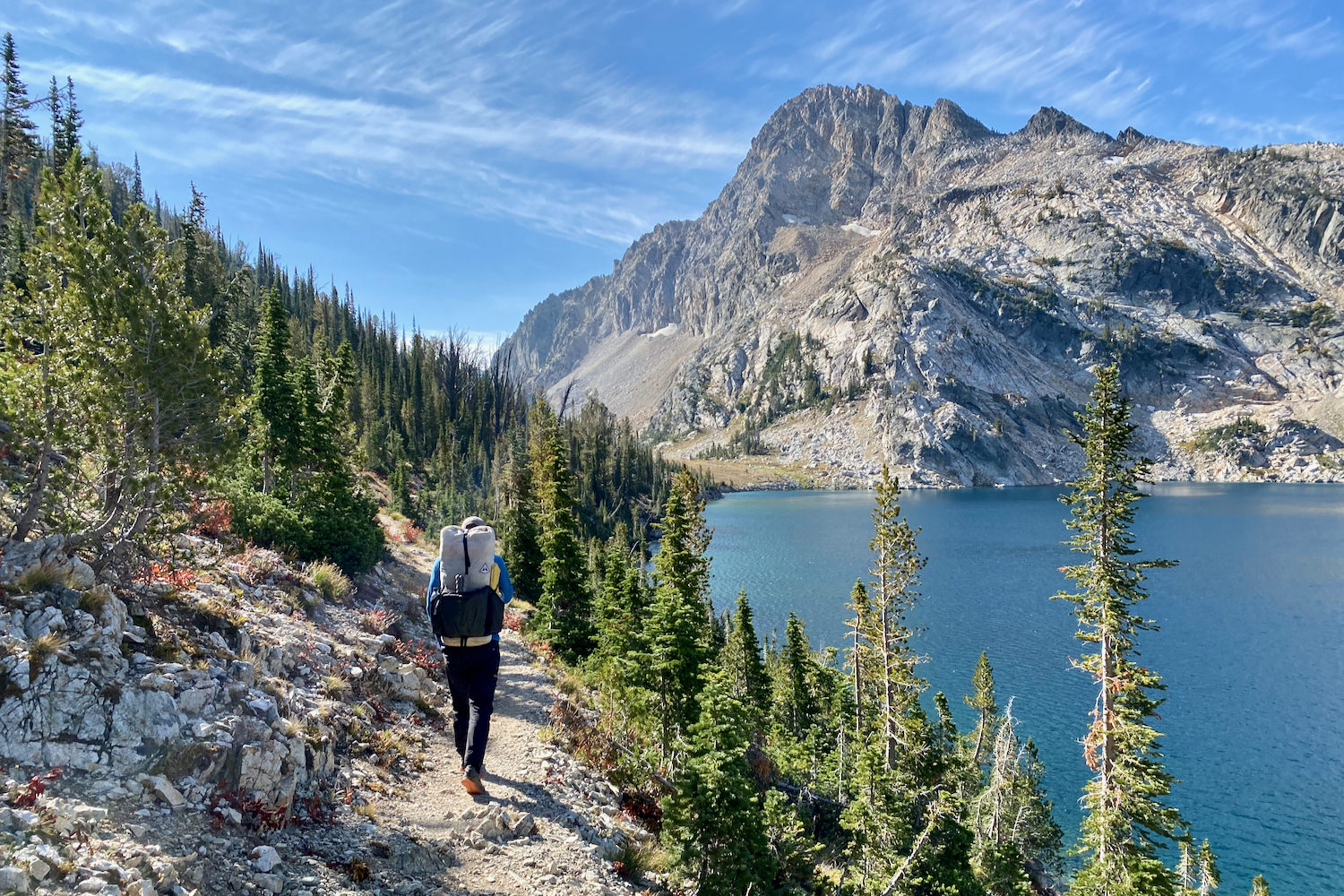
Choosing the right backpack can make or break an adventure. Our skilled team of analysts at CleverHiker knows a thing or two about backpack comfort, having hiked more than 20,000 miles over the past decade. Pretty much all of those miles included a backpack.
For the first time, we split off our favorite ultralight backpacks into a separate guide, leaving more room here to dig into lightweight, midweight, and heavyweight backpacks for multi-day trips. We stuffed these backpacks to their weight capacities, carrying each one on Minnesota trails to test its comfort, features, durability, and ease of use.
We looked at well established brands like Osprey, Gregory, REI, and Deuter but also smaller cottage brands like ULA and Granite Gear. And – to dig deeper into the budget category than we ever before – we braved the terrifying, endless pages of Amazon to find a budget pack that might check the right boxes.
And for more info, check out some of our other most popular gear guides:
Quick Picks for backpacking packs
Check out this quick list of the best backpacking backpacks, or continue scrolling to see our full list of favorites with in-depth reviews.
Best Backpacking Backpack Overall: Gregory Paragon 58 (Men’s) / Maven 58 (Women’s) ($260)
Best Budget Backpacking Pack: REI Flash 55 Men’s / Women’s ($199)
Best Backpack for Thru-Hiking: ULA Circuit ($300)
Best Load Hauler Backpacking Backpack: Gregory Baltoro 75 ($330)
Backpacking Pack with Classic Styling & Great Price: REI Trailmade 60 Men’s / Women’s ($180)
Best Lightweight Ventilation Pack: Osprey Exos 58 (Men’s) / Eja 58 (Women’s) ($260)
Backpacking Pack with Best Features: Osprey Atmos AG 65 (Men’s) / Aura AG 65 (Women’s) ($340)
Most Durable Backpacking Pack: Osprey Aether 65 (Men’s) / Ariel 65 (Women’s) ($320)
Best Crossover Backpacking Pack: Granite Gear Crown3 ($260)
Backpacking Pack with Amazing Comfort & Quality: Deuter Aircontact Ultra 50+5 ($250)
Acceptable Low Price Backpacking Pack: Nevo Rhino 65+5 ($85)
What’s new
Our one backpack guide has now become two!
This guide focuses on conventional (lightweight to heavyweight) backpacks for multi-day backpacking trips, and we now have a separate guide focused on ultralight backpacks. That means all new market research, testing, and a completely re-written guide from the ground up.
- Our new additions for this guide include the burly Gregory Baltoro 75 and the tempting budget REI Trailmade 60.
- We also waded through the pages of Amazon reviews to answer the question, “Why would I spend $300 on a backpack when this one off Amazon is the same?” We found the Nevo Rhino – and approached this budget backpack with an open mind.
- The Gregory Paragon jumped several spots to claim our top overall spot.
Backpacking Backpacks Overall Testing Scores
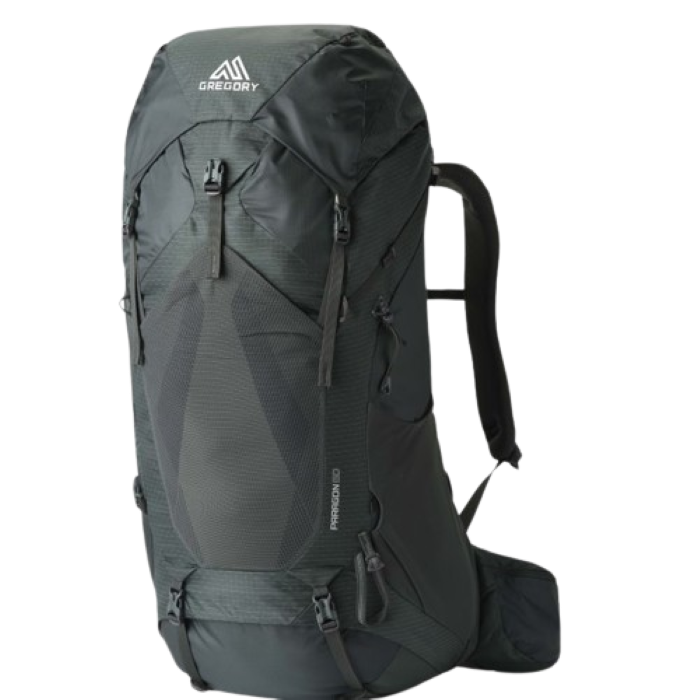
Gregory Paragon 60 / Maven 58
Best Backpacking Backpack Overall
CleverHiker Rating: 4.8/5.0
Price: $260
Weight: 3 lb. 8 oz.
Volume: 60 L / 58 L
Max Weight Rec.: 50 lb.
Pros
- Very comfortable
- Water bottle pocket easy to reach
- Side zipper access
Cons
- Heavier than its peers
- Only one bottle pocket has vertical opening
- Mesh on back pocket may lack durability
The Gregory Paragon 60 (Men’s) / Maven 58 (Women’s) have earned an Editor’s Choice badge and “best overall” backpack due to an exceptional balance of comfort, features, and price. Its supremely comfortable design stems from a combination of an excellent mesh back panel and supportive hip belt that effectively distribute weight, eliminating pressure points. The side zippers allow easy access to the main compartment and the bottom sleeping back pocket, ample compression options, and external lashing points add to its versatility. The Paragon’s design is a result of thoughtful consideration of user needs, which our testing process confirmed: every part of the pack performed smoothly and delightfully.
However, the Gregory Paragon is not the lightest pack in its class, and some users might find it needlessly heavier than other models Continuing with the downsides, the mesh back pocket, though high quality, does raise some durability concerns, and the tat only one water bottle pocket has a vertical opening might be a minor inconvenience for some. The hip belt pocket zippers also don’t close one-handed. Despite these drawbacks, they are relatively minor compared to the overall performance and comfort of the pack.
Overall, we found it offered a premium experience that delivers on all fronts, making it our editor’s choice for best overall backpack. It may not be the lightest or most fueature0rich, but its combination of comfort an user-friendly design makes it a reliable and enjoyable pack for a wide range of backpacking adventures. If you’re a backpacker who values a well-rounded experience – and you’re willing to carry lightly more weight for it – the Paragon is an excellent choice.
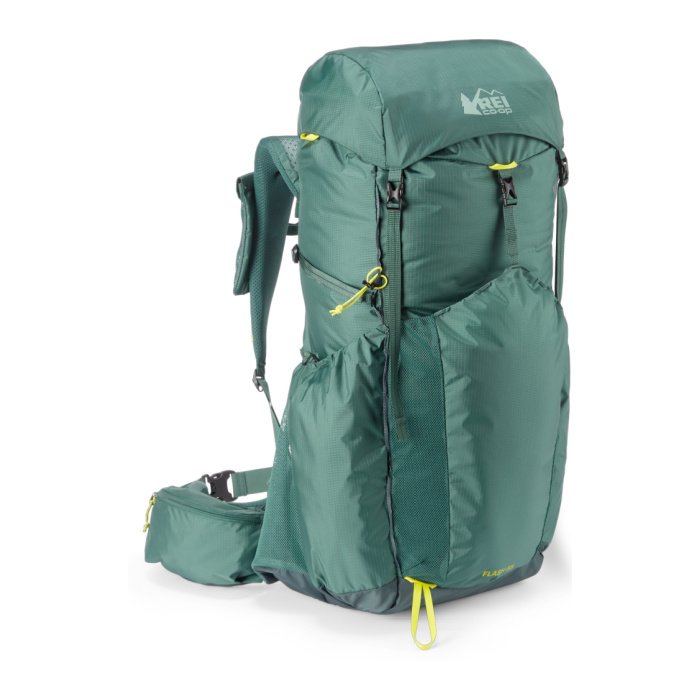
REI Flash 55
Best Backpacking Backpack Overall
Price: $199
Weight: 2 lb. 13 oz.
Volume: 55 L
Max Weight Rec.: 40 lb.
Pros
- Less expensive
- Lightweight
- Very comfortable
- Good pocket organization
- Very easy to access water bottles
- Can remove components to reduce weight
Cons
- Mesh hipbelt pocket lacks durability
- Bladder clip can snag gear
The REI Flash 55 (Men’s) / (Women’s) costs significantly less than comparable backpacking packs, but it doesn’t skimp on quality or features. This pack is light, versatile, and comfortable, so it’s a great option for lightweight backpackers on a budget.
The Flash 55 has a truly unique element called “Packmod.” This modular system allows you to quickly and easily remove the straps and pockets and reconfigure them into several combinations, or you can leave them at home to save weight. So the Flash easily transitions from a lightweight weekend backpacking pack to a trusty hauler for heavier loads.
We also absolutely love the Flash 55’s forward-facing water bottle pockets. This may seem like a small detail, but if you’ve ever sweat and nearly dislocated your shoulder to reach an upright bottle, you’ll know exactly how big this is.
CleverHiker Senior Gear Analyst, Casey Handley, has taken the Flash 55 on many adventures – including the stunning Timberline Trail around Mt. Hood – and she loves the comfort, low weight, and convenient pockets of this pack. But as a hiker who likes to keep things as light as possible, Casey’s favorite feature is the modular design that allows her to tailor the pack for each hike – taking only what she needs and nothing she doesn’t.
The Flash 55 is the most affordable backpack on our list, but you’ll want to make sure your pack weight is dialed in before choosing it. Hikers carrying more than 30 pounds will likely want to spend a bit more for a bag with a beefier frame, as this pack’s comfort diminishes quickly above that weight. That said, budget-conscious lightweight backpackers who have finely tuned their pack weight should look no further than the Flash 55.
Full review: REI Flash 55
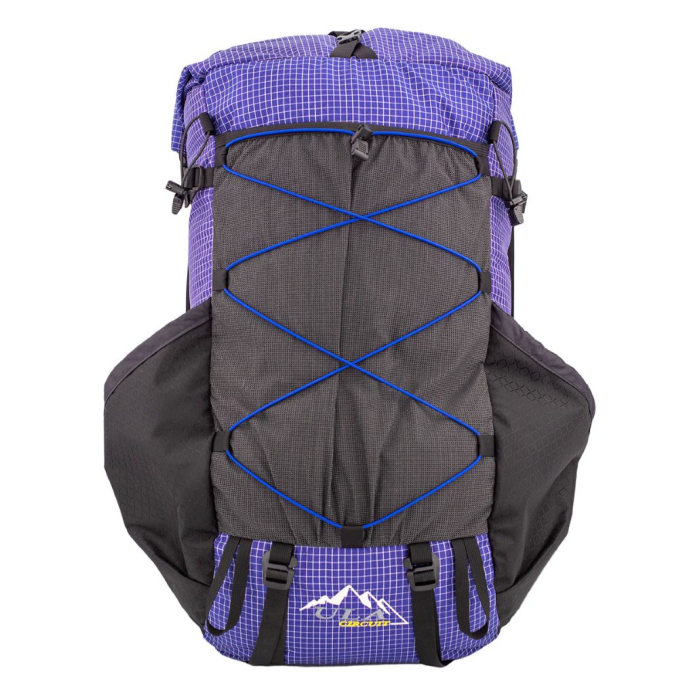
ULA Circuit
Best for Thru Hiking
CleverHiker Rating: 4.6/5.0
Price: $300
Weight: 2 lb. 7.5 oz.
Volume: 68 L
Max Weight Rec.: 35 lb
Pros
- Excellent hauling capacity for the weight
- Durable construction
- Great feature set for thru-hikers
- BV500 bear vault fits horizontally in pack
Cons
- Back panel offers limited ventilation
- Hip belt pocket zippers a bit stiff
- Water bottle pockets not easy to access
After thru-hiking thousands of miles with the ULA Circuit we can confidently say it’s an exceptionally durable backpack for long distance hiking. If you have your pack weight below 30 pounds the Circuit’s frame will carry your load very comfortably.
CleverHiker Gear Analyst, Heather Eldridge, has used the Circuit for her thru-hikes of the PCT and CDT as well as many small trips. She loves this bag because it has the perfect balance of durability and low weight – making it through multiple thru-hikes of over 2,000 miles each and then still going is no easy feat for an ultralight backpack.
The Circuit now comes with a more durable mesh front pocket, it’s compatible with ULA’s removable Y-strap and bottom strap, and – to be quite frank – it got a much-needed aesthetic makeover.
All the little design elements on the Circuit really make it shine on trail – large, convenient pockets; light, durable fabric; and a minimal, yet highly effective suspension system. The giant hipbelt pockets keep essentials and snacks easily accessible, which are worth their weight in gold for hikers spending long days putting up big miles.
This backpack has an exceptional balance of weight, comfort, and durability, so it’s no wonder the ULA Circuit is consistently called out as a favorite by thru-hikers.
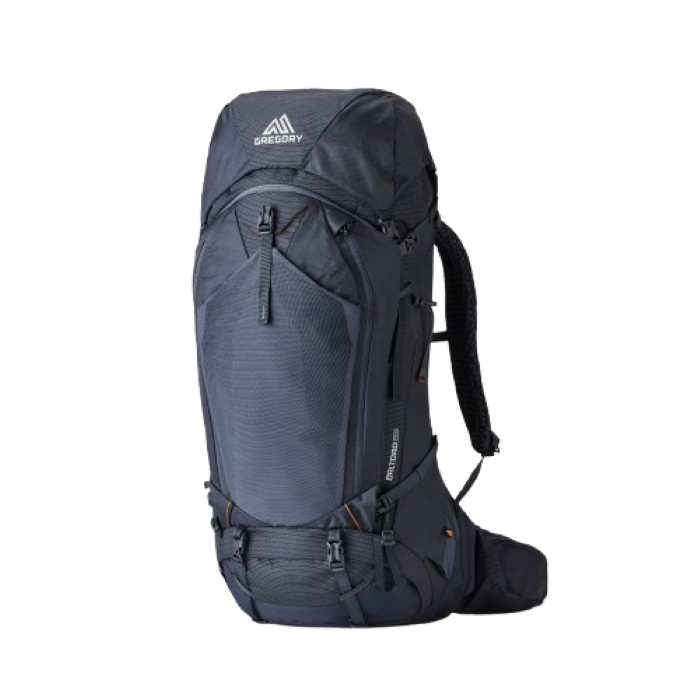
Gregory Baltoro 75
Best Load Hauler Backpacking Backpack
CleverHiker Rating: 4.6/5.0
Price: $330
Weight: 5 lb. 2 oz.
Volume: 75 L
Max Weight Rec.: 55 lb
Pros
- Excellent load carrying
- Great water bottle pocket
- Good array of features
Cons
- Heavy
- Use of mesh raises durability concerns
- Overkill for most backpackers
The Gregory Baltoro 75 earns its high place in our rankings due to its exceptional ability to carry heavy loads while maintaining a high level of comfort and a robust feature set. This pack’s excellent load carrying capability is primarily due to its wishbone aluminum frame, which effectively transfers weight to the lumbar pad and hip-belt. We like how that well-designed hip belt conforms to the body, improving comfort and preventing pressure points. The Baltoro also features a great water bottle side pocket that is easy to access and can be tucked away when not in use. To help with access and organization, it features a U-shaped zipper for getting inside, and two side zippers to dedicated pockets.
There’s a lot of good here, but the Baltoro isn’t ideal for all backpackers. The pack is heavy, so it may not be suitable for those who prefer lighter loads. The Baltoro may also be overkill for backpackers who don’t haul very heavy loads, The many features can also be a bit overwhelming, making it important to familiarize yourself with the pack before heading out into the backcountry.
The Gregory Baltoro 75 is an excellent choice for backpackers who need to carry heavy loads and require a durable and feature-rich pack. It is a great option for expeditions, guides, and those who need to carry specialized equipment. However, we do not recommend the Baltoro for casual backpackers or those who prefer to travel light. For those who need the load-hauling capability, this pack is an excellent choice that is comfortable and durable.
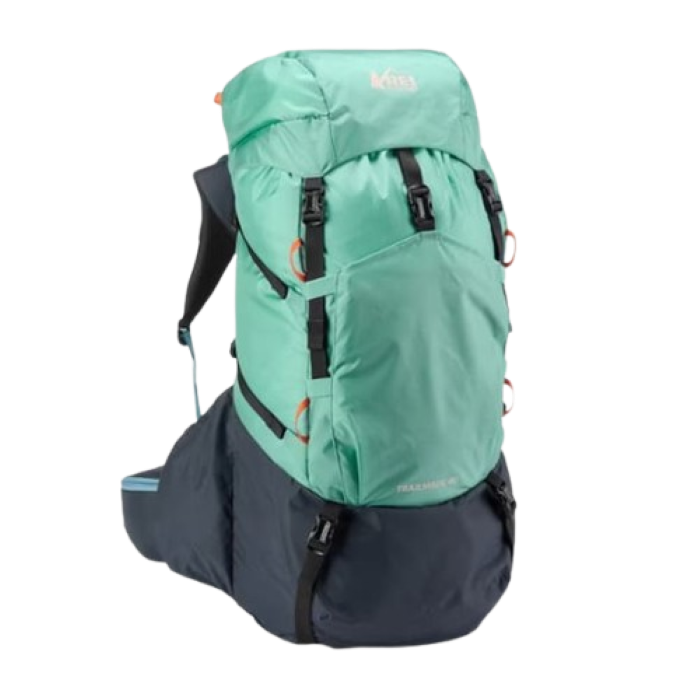
REI Trailmade 60
Backpacking Backpack with Classic Styling & Great Price
CleverHiker Rating: 4.4/5.0
Price: $180
Weight: 3 lb. 5 oz.
Volume: 60 L
Max Weight Rec.: 40 lb
Pros
- Durable material selection and construction
- Good water bottle access
- Great feature set for beginners
Cons
- Too close in price to lighter and more featured packs
- Average comfort
The REI Trailmade 60 (men’s / women’s) is a solid, entry-level backpack that prioritizes durability and ease of use, making it a good choice for beginner backpackers. We’ll admit, this pack grew on us as we tested it. Our first impressions were just of a “basic” pack from REI. But we eventually began to appreciate the thoughtfulness in the design and the careful feature list that would be useful but not overwhelming to beginners.
Starting with positives, it has a durable construction, featuring solid nylon and no mesh that gives it a reassuring feel and makes it less likely to rip or tear. The water bottle pockets are positioned close to the hip belt, which allows for easier access than competing backpacks. The hip belt pockets are also large, easy to use, and made of solid face fabric, increasing their durability. The pack’s simple and straightforward design, along with a classic style, makes it easy to use, even for those new to backpacking.
However, the Trailmade 60 does have some drawbacks. With basic foam padding, its comfort is only average compared to other packs. The lumbar padding has a gap for airflow that could potentially create a pressure point for some users. Additionally, the pack’s features are well-suited for beginners, but it lacks some premium features like a U-shaped internal access zipper or an ice axe loop. The Trailmade 60 is also not as light as many of its peers – though the weight is reasonable for a pack in this price range.
In conclusion, the REI Trailmade 60 is a good option for those just getting into backpacking and looking for a durable, easy-to-use pack with a classic design. It excels at the basics, offering good water bottle access and sturdy construction. However, more experienced backpackers or those prioritizing comfort and weight savings may want to look at other options that offer more features and better ventilation. None of that detracts that on its own, the Trailmade is a good pack – one we grew to enjoy the more we used it.
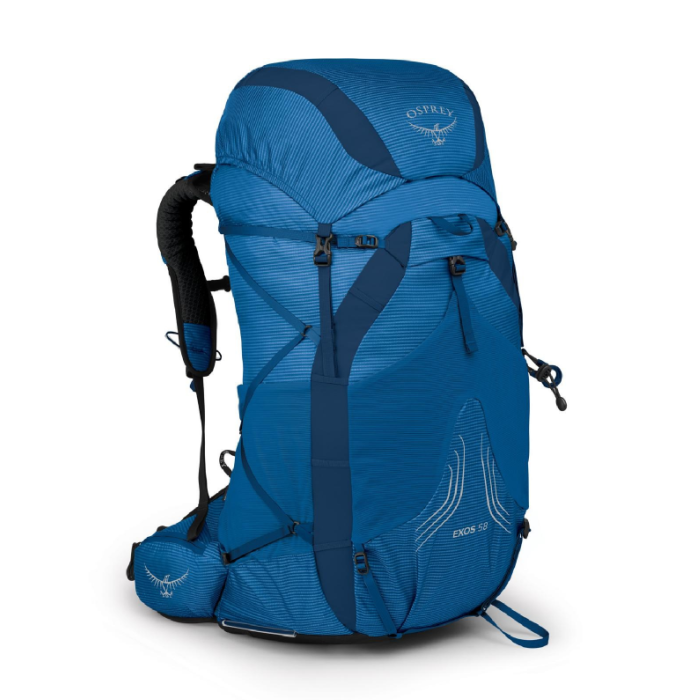
Osprey Exos 58 / Eja 58
Best Lightweight Ventilation
CleverHiker Rating: 4.4/5.0
Price: $260
Weight: 2 lb. 13 oz.
Volume: 58 L
Max Weight Rec.: 35 lb.
Pros
- Excellent ventilation and comfort
- Good hip belt pockets
- Lightweight for a framed pack
Cons
- Shifted center of gravity makes pack feel heavier
- Frame may rub on muscles
The Osprey Exos 58 (Men’s) / Eja 58 (Women’s) are long-time favorites of lightweight backpackers – and the CleverHiker team – because of their comfort, well-ventilated back panel, and approachable price.
The tensioned-mesh frames of the Exos and Eja are sturdier than most lightweight pack frames and can carry heavier loads more comfortably. When one of our gear testers used the Exos for a test hike up Misery Ridge in Central Oregon – a relentlessly steep trail – he was very pleased with how well the AirSpeed Suspension ventilated during intense activity on a sunny day. In addition, he noted that the frame and suspension transfer weight to the hips well and can make the load feel a bit lighter than it is.
The latest iteration of the Exos/Eja brings back hipbelt pockets – a component that was sorely missed on the previous iteration – and while we’re happy to have the pockets, they’re very small. When the hipbelt is fastened, the pockets sit tight against your hip bone and make it pretty tough to get larger items in or out. Don’t expect to fit a smartphone inside these pockets, but storing small, commonly used stuff, like chapstick, a lighter, and a snack will work.
That gripe aside, the Exos and Eja are lighter and more affordable than many of the comparable packs on the market. So if you’re looking for the best balance of comfort, weight, capacity, and price you’ve found it with the Exos and Eja.
Full review: Osprey Exos & Eja
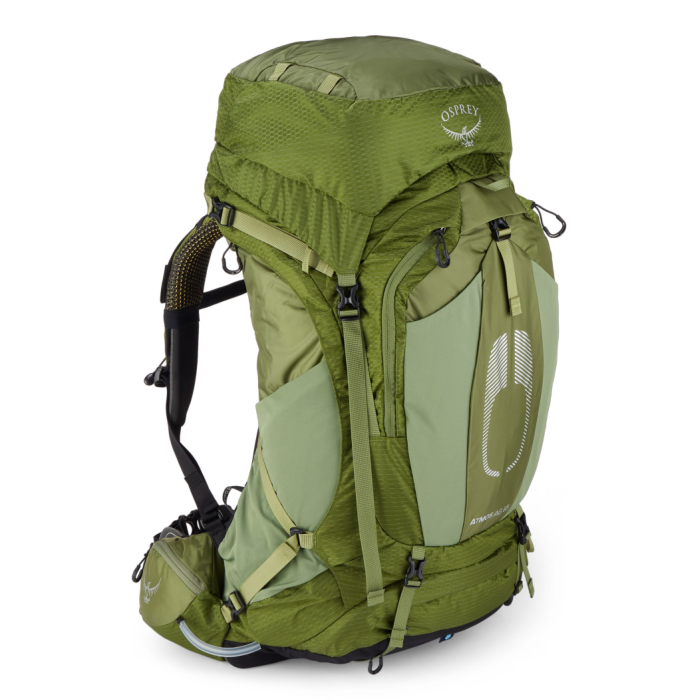
Osprey Atmos 65 / Aura AG 65
Backpacking Backpack with the Best Features
CleverHiker Rating: 4.4/5.0
Price: $340
Weight: 4 lb. 10 oz.
Volume: 65 L
Max Weight Rec.: 40 lb.
Pros
- Can comfortably hold heavier loads
- Breathable & well-padded frame
- Above-average durability
- Sturdy frame transfers weight to hips well
- Very comfortable suspension
- Plenty of room for extra/bulky gear
- Lots of organization
- Very easy to access water bottles
Cons
- Expensive
- Heavy
The Osprey Atmos 65 / Aura 65 is an incredible piece of technical gear, sporting a great feature set, comfortable back panel, durable construction, and huge amount of adjustability. These features combine to create a versatile pack ready for a variety of backpacking situations – but one we think is overkill for most backpackers.
That doesn’t change the fact that it’s still a quality piece of kit. The whole thing has a sense of rigidity to it that admittedly does make getting it on and off a bit cumbersome. But it feels reassuring once it’s situated. We liked the excellent hip belt pockets for how much they could store, and the water bottle pockets are easy to access. There’s also no denying how comfortable the whole experience is. That large mesh panel really does a good job conforming to a body shape to provide great support while reducing hot spots.
However, it’s easy to forget that the Atmos is still very expensive and heavy. And for that weight, you don’t even get a frame that can haul the heaviest loads, its carry limit is barely higher than packs that weigh nearly half as much. Additionally, the Atmos can also be a bit much sometimes, the abundance of features can sometimes make the overall experience more complex than simpler packs.
So in the end, we’re left with a feature-rich backpack that promises a premium experience and delivers on that goal. It’s a good choice for people who appreciate having a wide array of options. But those who prefer a simpler design or a more budget-friendly option should look at other packs.
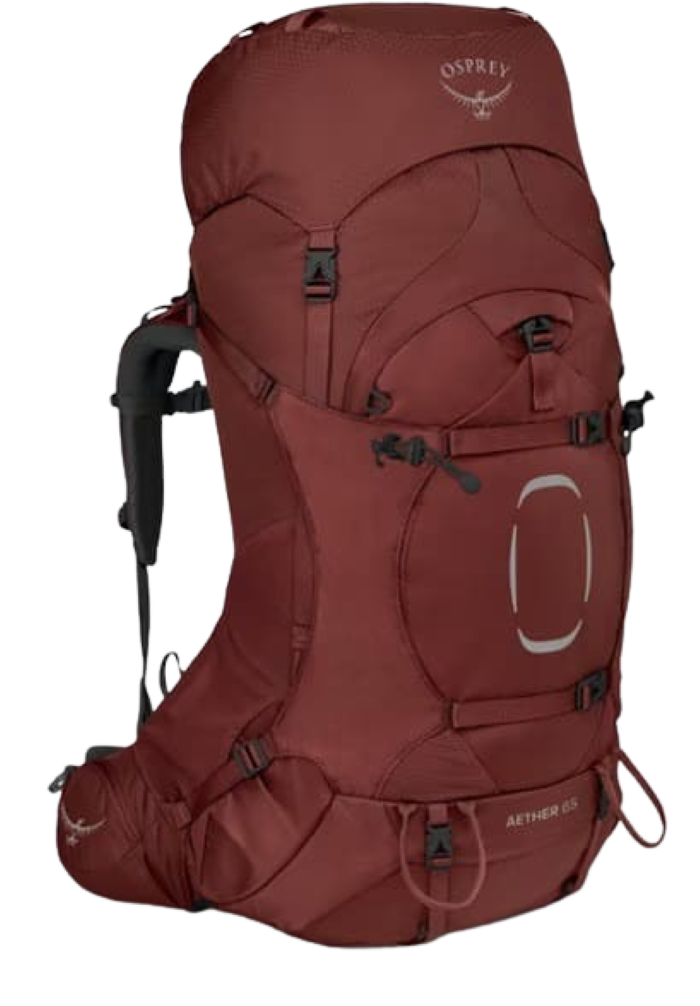
Osprey Aether/Ariel 65
Most Durable Backpacking Pack
CleverHiker Rating: 4.3/5.0
Price: $320
Weight: 5 lb. 2 oz.
Volume: 65 L
Max Weight Rec.: 60 lb
Pros
- Extremely durable
- Great feature set
- Good load hauling capability
- Good water bottle access
Cons
- Comfort isn't as good as competition
- Heavy
- Overkill for most backpackers
The Osprey Aether 65 / Ariel 65 is a highly durable pack with a great feature set and good load-hauling capability, making it a solid choice for those with specialized backpacking needs. It has a variety of features that make it tempting to those who want all the bells and whistles (and its sternum strap includes a whistle!) The ability to adjust torso length while wearing the pack is a unique feature that’s helpful to dial in the perfect fit or adjust as the load increases. The Aether uses thick 210D and 420D nylon and limits mesh use smartly, making it the most durable pack tested. The pack also has good water bottle access, with a clever vertical pocket design that accommodates both Smartwater and Nalgene bottles. The Aether’s durable construction and capacity make it ideal for those needing a reliable pack for demanding adventures.
It does have a few drawbacks, but it’s notable that this pack isn’t meant for the generalist backpacker. It’s aimed at heavy haulers who know what they’re getting into. Therefore to say that the pack is heavy only tells half the story. Most of that weight is to support a beefy frame that can haul 60 pounds of gear. But at those weights, we actually thought other packs provided a more comfortable experience. If you’re a regular backpacker, there are packs half this weight that still haul normal weights extremely comfortably. Plus, those same lighter packs are also cheaper since the burly design and construction makes the Aether pricey.
All of those features add up to a pack that can handle backpacking with ease, but is really made for a bit more. Guiding, light mountaineering, base-camp style expeditions, and long treks off trail where durability is vital. These are areas where the Aether will excel beyond other packs and show why it commands such a weight and price premium. But for someone enjoying their local trail on a weekend or even thru hiking for months, most of what makes this pack unique simply won’t be utilized fully.
If you’re in the market for a load hauling pack, the Aether is still a great option. It might not be the most comfortable pack we tested for heavier weights. However, comfort varies from person to person, so it’s always best to try on a pack for yourself. Ultimately, the Aether is a reliable and feature-rich pack designed for those who need a heavy-duty backpack with a strong build that will last for years.
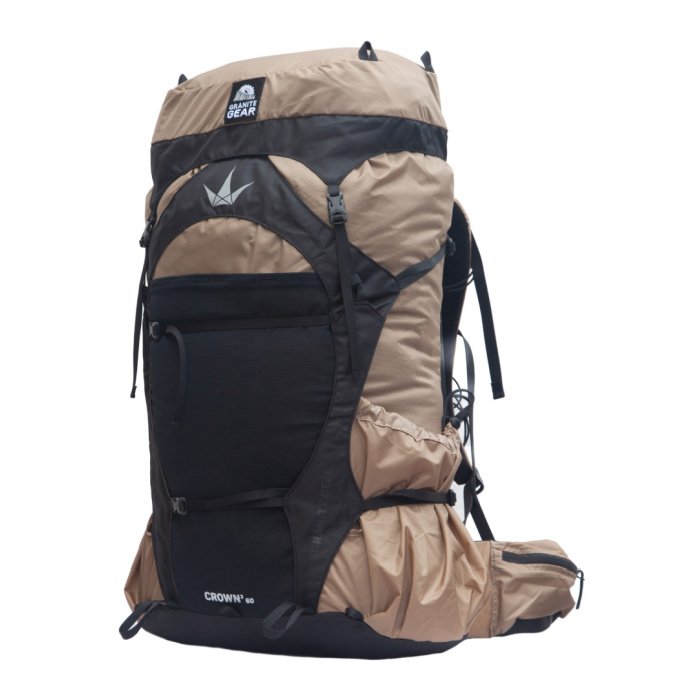
Granite Gear Crown3
Best Crossover Backpacking Pack
CleverHiker Rating: 4.2/5.0
Price: $260
Weight: 2 lb. 12.5 oz.
Volume: 60 L
Max Weight Rec.: 35 lb.
Pros
- Cross between lightweight & traditional pack
- Extensive exterior lashing options
- Great hip belt pockets
Cons
- Not comfortable at 35+ pounds
- Narrow shoulder straps
- Awkward water bottle pockets
The Granite Gear Crown3 60 is a versatile crossover pack that adapts to both lightweight and traditional backpacking styles, so it’s a great option for those who can’t decide between the two. The pack features a huge amount of exterior lashing options and great hip belt pockets, making it easy to carry gear in various configurations. The compression system allows the bag to cinch down for smaller trips or expand to carry an impressive amount. That’s something few packs can offer. Although it’s made from decently durable materials, we love to see that it’s made with recycled fabrics with an undyed option, showing an effort towards better sustainability.
The Crown3 is not without its drawbacks. The pack’s comfort falls off as the weight rises, and we found the polypropylene sheet isn’t capable of supporting heavier loads. Thankfully Granite Gear does offer an aluminum frame that can snap into the sheet, but that’s extra. At those higher weights though, the narrow shoulder straps started to feel a bit fatiguing, and we wish Granite Gear would make them a bit wider. The water bottle pockets are also awkward, being too high to be used comfortably, and the included chest bottle mount that’s supposed to alleviate this problem is not great.
The negatives don’t outweigh the fact that we loved the Crown3. We think it’s a great option for those who want a versatile pack that can handle both lightweight and traditional backpacking. Backpackers who prioritize comfort or need a pack for heavy hauling may want to consider other options. Ultimately, the Crown3 is a versatile pack that offers a good balance of features and adaptability, making it a great choice for those who want to explore different backpacking styles.
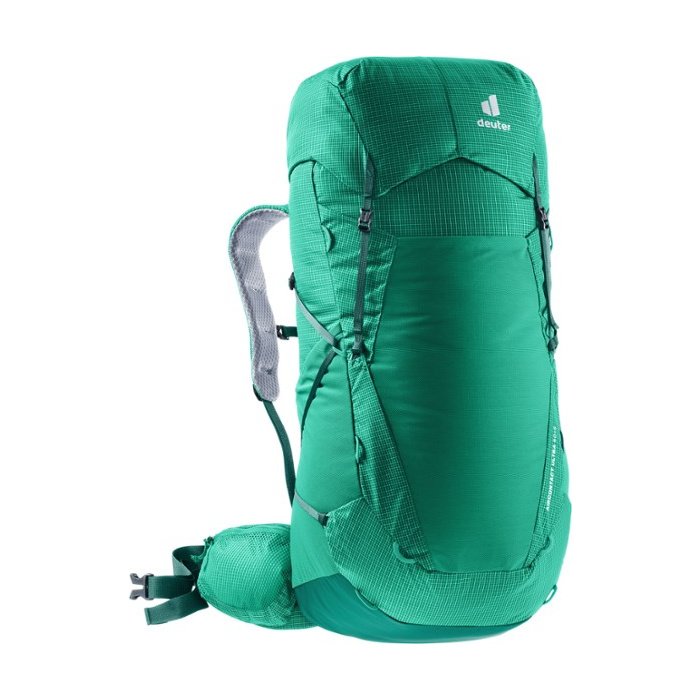
Deuter Aircontact Ultra 50+5 / 45+5
Backpacking Pack with Amazing Comfort & Quality
CleverHiker Rating: 4.1/5.0
Price: $250
Weight: 2 lb. 15 oz. / 2 lb. 10 oz.
Volume: 55L / 50L
Max Weight Rec.: 35 lb.
Features: 4.5
Durability: 4.2
Ease of Use: 3.8
Pros
- Adjustable torso
- Comfortable
- Sleek design
- Excellent buckles
Cons
- Floppy hip belt pockets
- Water bottles are slightly cumbersome to access
- Lower durability mesh components
The Deuter Aircontact Ultra 50+5 / Ultra 45+5 is a comfortable pack with a sleek design and great comfort. The smart arrangement of foam pads creates a more comfortable fit than any other traditionally padded pack, easing pressure points even when loaded with 30 pounds of weight. The pack also boasts great lashing points for customizing its external carrying capacity. The buckles are a standout feature, being small but easy to clip and unclip – an underappreciated detail that helps make day to day use easier.
Though we’re a bit obsessed with how comfortable this thing is, some unfortunate downsides make the overall experience more mixed. The water bottle pockets are too high to be usable while wearing the pack, and the compression cords go over the pockets, making them impractical to use if there’s a bottle inside. The hip belt pockets are floppy, hard to access, and made of mesh, which makes us think they’ll be the first part to wear out or catch on a branch while bushwacking. The large back pocket is also made entirely of mesh, another potential weak spot for durability.
The Aircontact Ultra 50+5 is best suited for backpackers who want a straightforward and comfortable experience. For someone backpacking on established trails, doesn’t mind the hip belt pockets, and prefers hydration bladders to water bottles, this could be a great pack.
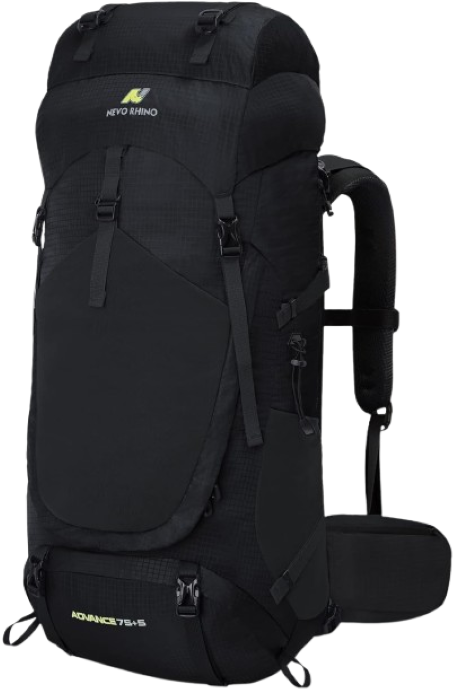
Nevo Rhino 65+5
Acceptable Low Price Backpacking Pack
CleverHiker Rating: 3.6/5.0
Price: $85
Weight: 5 lb.
Volume: 70 L
Max Weight Rec.: NA
Pros
- Affordable
- Good feature set
- Has internal frame
- Good hip belt comfort
Cons
- Poor quality construction and stitching
- Uncomfortable back panel
- Heavy
The Nevo Rhino 65+5 is an affordable pack with a good feature set and an internal frame, making it a tempting option for budget-conscious backpackers. However, we’ll spoil the conclusion here – you probably shouldn’t buy this pack. Save up for something better.
We initially looked at this because we were hopeful to find a diamond in the rough amongst the pages and pages of Amazon listings. But even though this was the most promising option we found, it still ended up underperforming. Even when taking into account its rock bottom price, we don’t think it’s a good purchase.
There is some good here, though. The hip belt provides a decent amount of support and comfort, thanks to its wide foam design that distributes the load effectively. The pack also includes a variety of features, such as large hip belt pockets, an adjustable torso, a rain cover, a sleeping bag compartment, side zippers, a U-shaped zipper, a top lid, side straps, and stretchy ice axe securement cords. These features, while functional to varying degrees, aim to appeal to a wide range of users.
However, the N Nevo Rhino has several significant drawbacks. The pack has poor quality construction and stitching, with seams flexing and showing threads when we just pulled on them with our hands. The back panel is also uncomfortable, not suitable for long hours on the trail. The water bottle pockets are too high to be usable while wearing the pack, and the back stretch pocket clips to a point that is covered by the top lid. The design seems to be a copy of existing packs without much thought for how the pieces fit together.
In summary, the N Nevo Rhino is a budget pack that does not offer a great long-term value. It’s functional – we could take it on a trip and survive – but our confidence is low that we’d enjoy our time with it. The only case where we can recommend someone purchasing it would be if you need a backpack for one trip – and one trip only – and need it fast. For everything else, buy used and get something better for the same price. Ultimately, the N Nevo Rhino is an example of a pack that is exactly what you would expect for the price: a pack with a collection of features that lack a thoughtful design and quality construction.
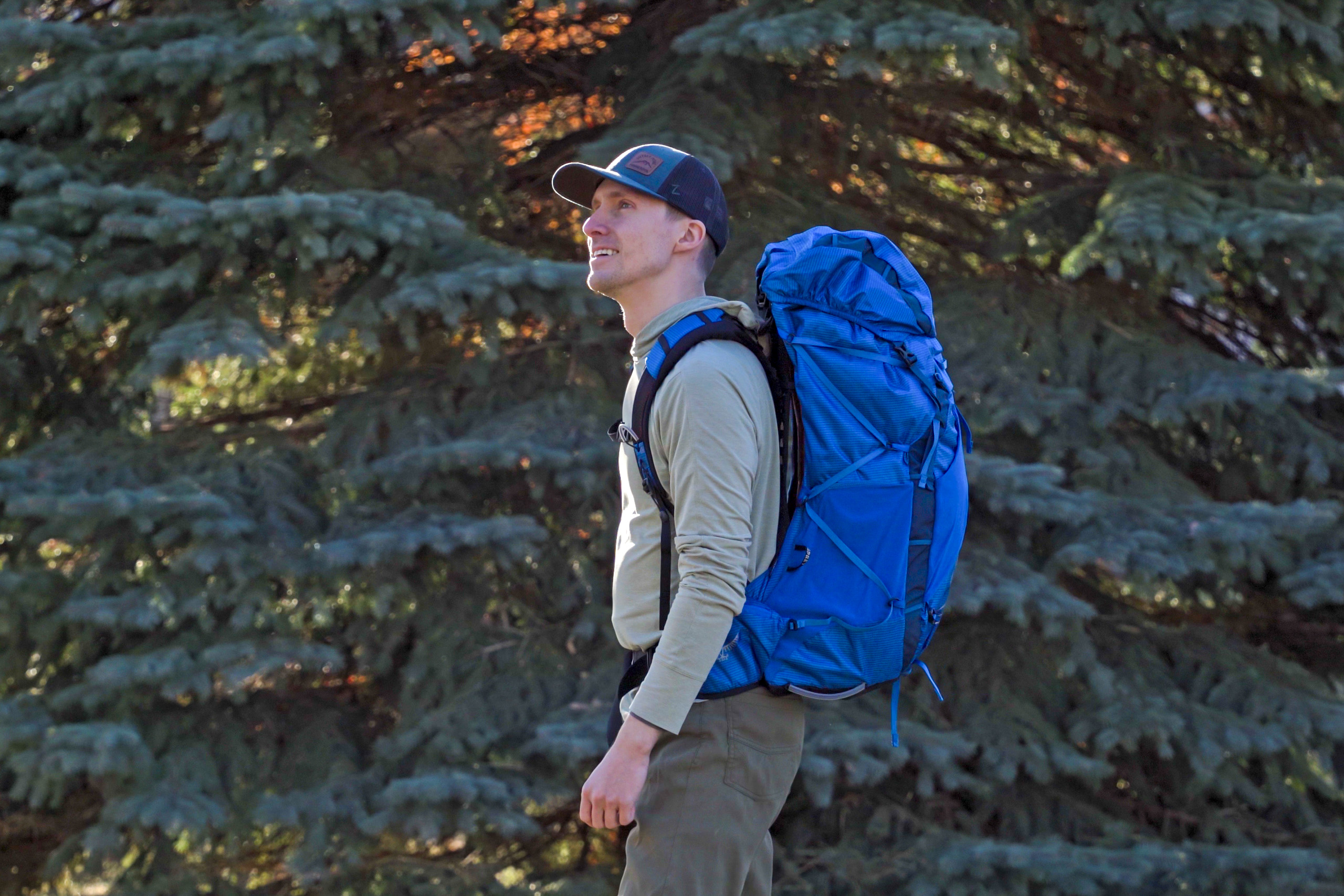
Product Comparison Table
| oSort | Product | Price | Weight | Volume | Max Weight Rec. | Comfort | Features | Durability | Ease of Use | 0 |
Gregory Paragon 60 / Maven 58 View Men's View Women's |
$260 | 3 lb. 8 oz. | 60 L / 58 L | 50 lb. | 4.9 | 4.7 | 4.5 | 4.6 | 1 |
REI Flash 55 View Men's View Women's |
$199 | 2 lb. 13 oz. | 55 L | 30 lb. | 4.3 | 4.5 | 4.3 | 4.4 | 2 |
ULA Circuit View at ULA |
$300 | 2 lb. 7.5 oz. | 68 L | 35 lb | 4.5 | 4.4 | 4.8 | 4.7 | 3 |
Gregory Baltoro 75 View at REI |
$330 | 5 lb. 2 oz. | 75 L | 55 lb | 4.5 | 4.7 | 4.6 | 4.5 | 4 |
REI Trailmade 60 View Men's View Women's |
$180 | 3 lb. 5 oz. | 60 L | 40 lb | 4.6 | 4.9 | 4.7 | 4.4 | 5 |
Osprey Atmos 65 / Aura AG 65 View Men's View Women's |
$340 | 4 lb. 10 oz. | 65 L | 40 lb. | 4.6 | 4.9 | 4.7 | 4.4 | 6 |
Osprey Exos 58 / Eja 58 View Men's View Women's |
$260 | 2 lb. 13 oz. | 58 L | 35 lb. | 4.6 | 4.5 | 4.3 | 4.4 | 7 |
Osprey Aether/Ariel 65 View Men's View Women's |
$320 | 5 lb. 2 oz. | 65 L | 60 lb | 4.2 | 4.8 | 4.9 | 4.4 | 8 |
Granite Gear Crown3 View at Granite Gear |
$260 | 2 lb. 12.5 oz. | 60 L | 35 lb. | 4.2 | 4.6 | 4.4 | 4.2 | 9 |
Deuter Aircontact Ultra 50+5 / 45+5 View Men's View Women's |
$250 | 2 lb. 15 oz. / 2 lb. 10 oz. | 55L / 50L | 35 lb. | 4.8 | 4.5 | 4.2 | 3.8 | 10 |
Nevo Rhino 65+5 View at Amazon |
$85 | 5 lb. | 70 L | NA | 3.5 | 4.6 | 3.6 | 3.8 |
|---|
How We Test & Methodology
For this edition of the gear guide, we started fresh and re-wrote and re-tested the entire lineup of backpacks. Since this testing started during winter, it wasn’t possible to test typical three season backpacking conditions, so we focused on testing what metrics we could to give a good representation of how these packs will perform.
COMFORT
Based on each pack’s maximum weight rating, we loaded it up with 35 or 50 pounds of gear and took it out on some Minnesota trails to see how it handled the load. Since comfort is very subjective, we weren’t looking for specific comfort experiences. Rather, we evaluated how each pack’s comfort and support features performed in the field. For example, we paid special attention to the comfort of hipbelts, noted any pressure points, and evaluated adjustability.
We also looked at more basic metrics. How plush is the foam on the hip belt and shoulder straps? What’s the quality of the foam used? Do the adjustment buckles create pressure points? We attempted to evaluate back ventilation, but the winter testing environment made it challenging to assess accurately.
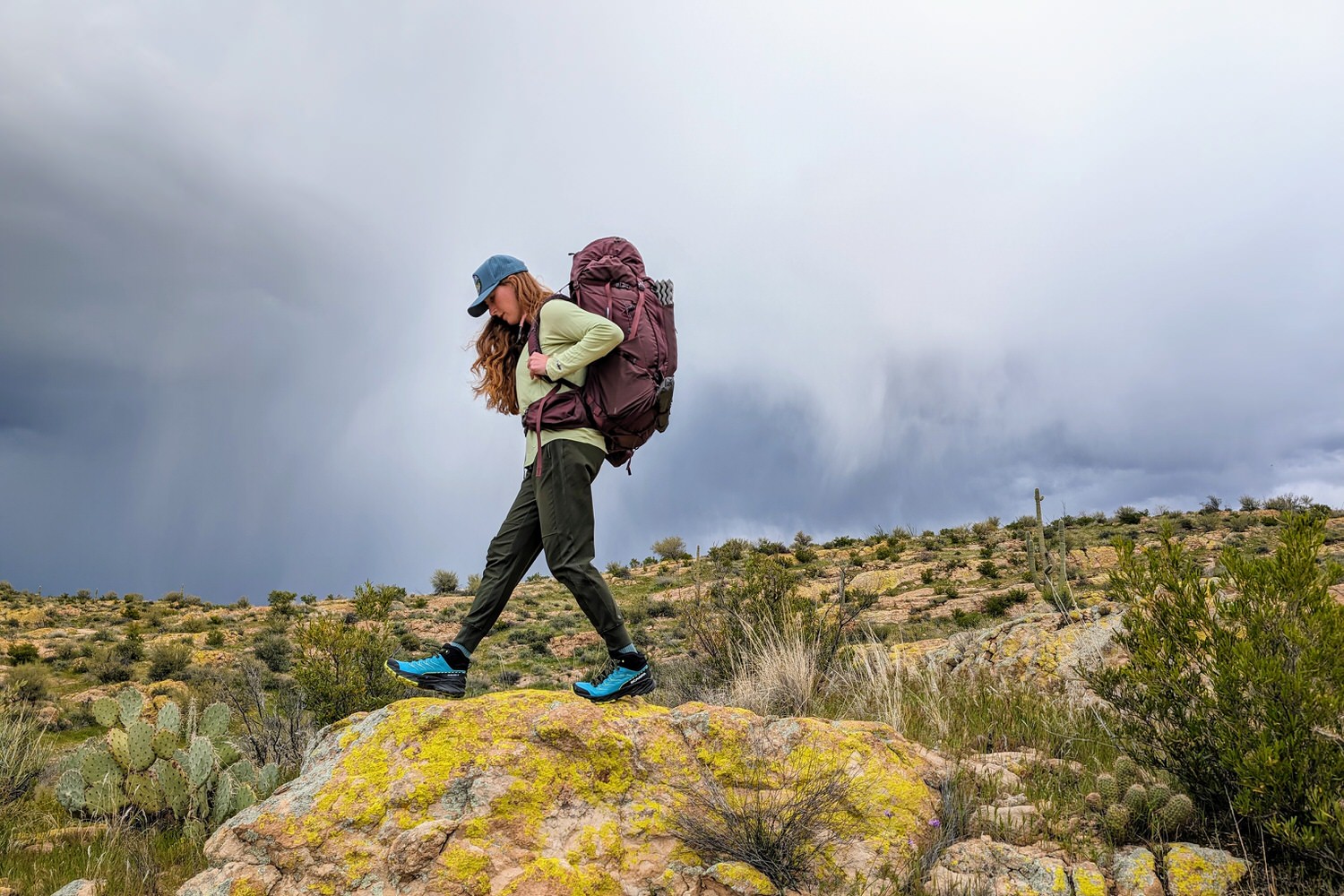
FEATURES
This category is also very subjective. Some backpackers prefer fully featured packs while ultralighters frequently complete trails with ridiculously minimalist setups.
Our analysis noted which packs had essential features (hipbelt pockets, water bottle pockets, back stretch pocket, sternum strap, side compression straps, internal frame, and load lifters) versus non-essential features that potentially add value but also add weight (dedicated sleeping bag compartment, floating top lid, ice axe loop, side zippers, U shaped main compartment zippers, hydration bladder pocket, adjustable torso length, included raincover, trekking pole attachment, bottom attachment straps, internal pockets). After wearing each pack, we made note of any features that we either missed or did not use and determined what type of backpacker would use each pack’s features the most.
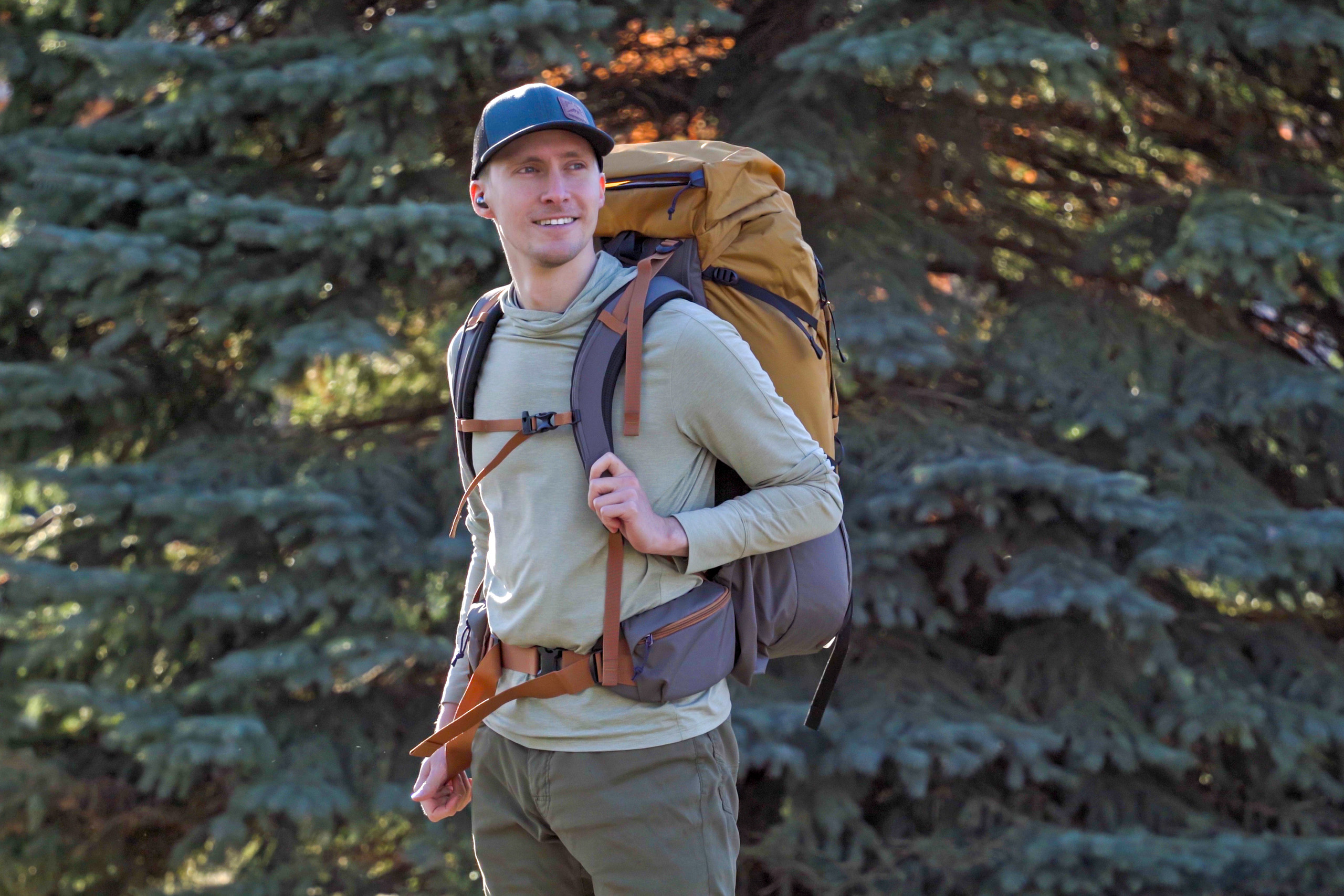
DURABILITY
For many backpacks, the best test of durability is to survive an entire hiking season on a multi-month thru hike. As this guide is starting fresh, we’ve yet to take these packs out on a true durability test, but there are some things that we can look at to give an indication of durability. Fabric thickness and quality is the most important metric here, with thicker and higher quality fabrics surviving better on an equal playing field. We also paid attention to stitching quality, the quality of plastic components, and the quality and placement of mesh – a common weak spot on backpacks in this class.
For this class of backpack, we’re not overly concerned with durability. All of them should last the length of a multi-month thru hike under normal use. Even the lightest pack here doesn’t get into the category of ultralight packs, which require special care for long-term durability.
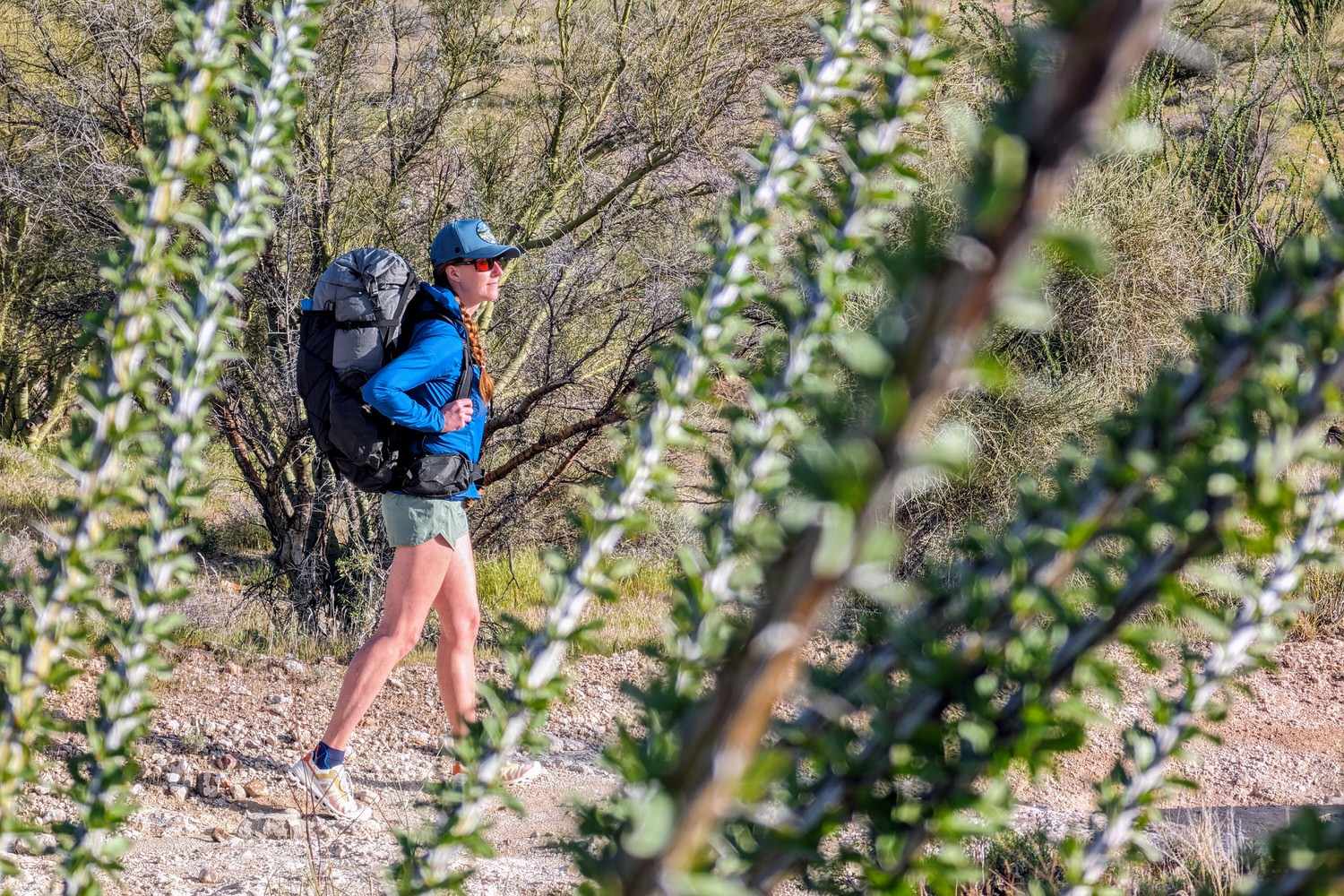
EASE OF USE
Backpacks are a straightforward category in many ways. However, there are certain design features that make packs easier to use or more frustrating. We paid attention to common trouble spots, such as water bottle pockets that are hard to access and compression straps over bottle pockets, which make them hard to access. We looked at hip belt pockets to see how easy they were to open and close one handed and how well they fit the larger phones.
On the flip side, we also looked for our favorite features, such as quick access to trekking poles on the front of the pack. Features like internal access side zippers or U-shaped zippers also add to overall ease of use, even if they’re not essential. Being able to adjust the torso height of a pack while wearing it is another nice – but not essential – feature.
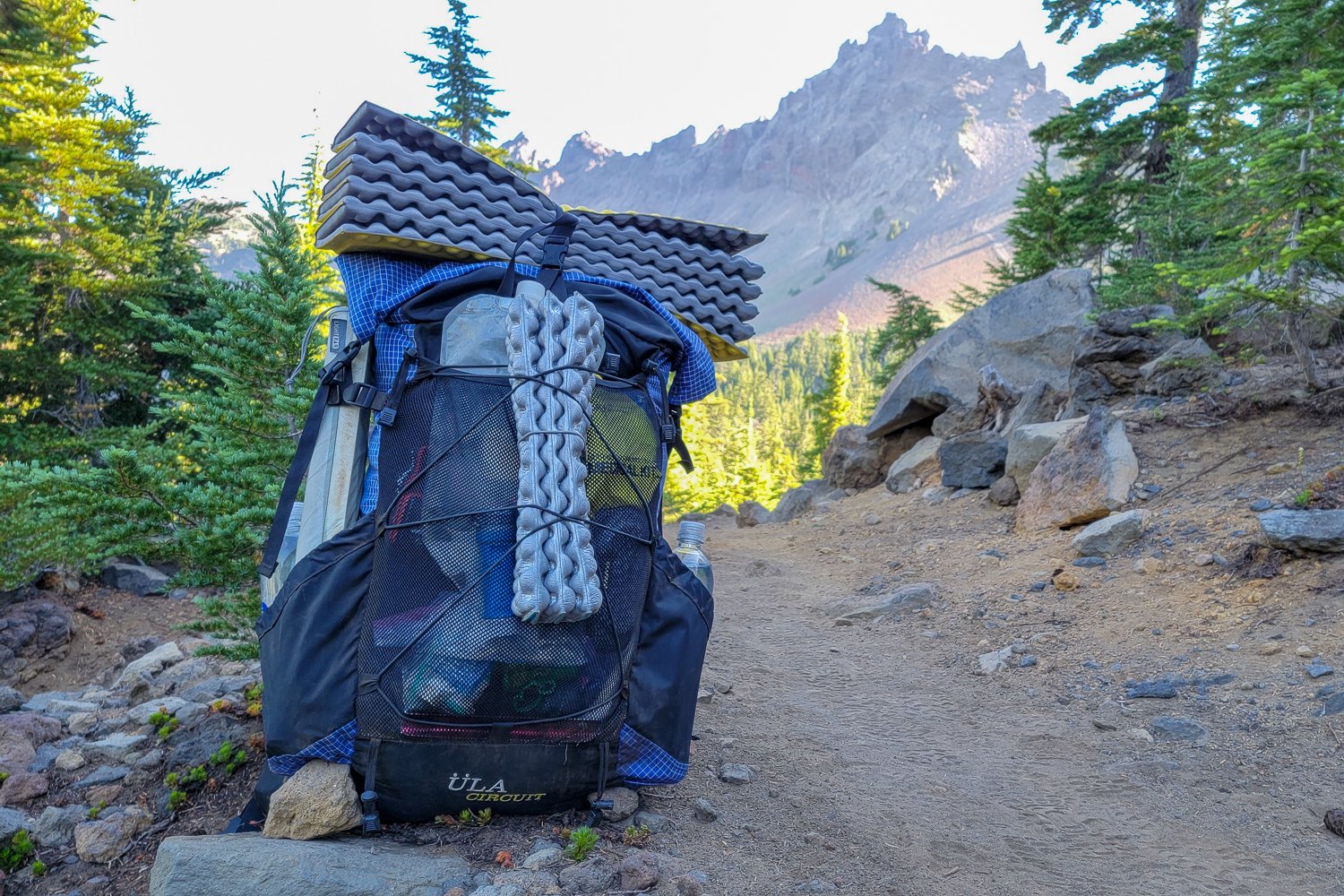
Why Trust CleverHiker
CleverHiker editors and analysts have spent more than 20,000 nights under the stars and clouds of the backcountry. Gear analyst Taylor Passofaro has been backpacking for more than 7 years, covering many of the midwestern United State’s most beautiful trails. He’s hiked the Pacific Crest Trail, the Superior Hiking Trail, Collegiate Loop, Laugavegur & Fimmvörðuháls trek, the Tour du Mont Blanc, and others.
He’s tested many backpacks while on treks, swapping out different styles, weights, and classes of packs as the adventures call for different requirements. His other life as a medical device research engineer brings a background of detail oriented testing to provide solid gear recommendations for any type of adventure.
Analysis & Results
We test backpacking backpacks along four dimensions – comfort, features, durability, and ease of use. Our hands-on, real-world testing is the best way we’ve found to properly assess each model – where it excels and what’s its most practical use case. Check out our analysis of the top performers in each dimension below.
VALUE
Backpacks are among the most expensive items in a gear list. They are one of the big four – along with a tent, sleeping bag, and sleeping pad – that comprise the core of a person’s outdoors gear. Therefore, we looked for backpacks that outperformed their price. For the best value, we recommend the REI Flash 55 and the Gregory Paragon 58.
Both of these packs are excellent performers in their own categories. The Flash 55 aims to be a more minimalist and lightweight pack at a lower price, and it nails the fundamentals while adding thoughtful features that make it stand out. For those reasons, it was an easy Budget Buy win. On the more traditional end of things, the Gregory Paragon 58 managed to hit the sweet spot of exactly what you want in a backpack, all in a smartly designed package. It’s heavier and more expensive than the Flash 55, but it also delivers a more comfortable and premium experience. And it manages to do that while also being more affordable than the other packs it competes against, giving it excellent value for what it delivers. Another pack that stood out for value was the REI Trailmade 60 for delivering great fundamentals at a good price.
We found the rest of our backpacks lumped into two groups. For average price and performance that delivered predictably average value, the Deuter Aircontact Ultra 50+5, Granite Gear Crown 3 60, and Osprey Exos 58 are all decent. And in the more expensive but specialized category, the Osprey Atmos 65, Osprey Aether 65, Gregory Baltoro 75, and ULA Circuit were pricey but good-performing packs. An outlier is the Nevo Rhino 65+5L, which delivered poor performance, but was such a low price that it ended up being a decent value in some ways.
COMFORT
In backpacking gear, comfort is king. However, comfort is also very subjective. What works for one body shape and type won’t necessarily work for another. The best way to ensure a comfortable pack is to try it on in person.
Based on our testing, the Gregory Paragon provided the best overall comfort. Other standouts were the Deuter Aircontact Ultra, Osprey Atmos, and Osprey Exos. The Aircontact takes a more traditional approach with smartly designed foam pads, and the Atmos and Exos both use a huge suspended mesh panel. The Paragon falls somewhere in the middle, with large sections of foam and mesh that come together to make an overall excellent experience.
Average performers for comfort were the ULA CIrcuit, Gregory Baltoro, REI Flash 55, Osprey Aether, and Granite Gear Crown. All of these were comfortable and, depending on body shape, should work well for most people.
A lower score was given to the REI Trailmade 60 for smaller foam back panels that we thought could be polarizing, and the Nevo Rhino is last with an odd fit and comfort that became fatiguing.
FEATURES
For the most part, the heaviest packs we tested packed in the most features. If you prefer lighter, more minimalist packs, please peruse our Ultralight Backpack Gear Guide. For this guide, the most decked-out pack we tested was the Osprey Atmos. With a huge array of options, its features include a solution, no matter the situation.
Close behind is its load-hauling cousin, the Osprey Aether. With a more traditional suspension system but similar features, it’s another pack that feels built for anything. The trend of heavier packs having the most features continues with the Gregory Baltoro and Gregory Paragon, both sporting well-rounded feature sets.
The Granite Gear Crown 3, Nevo Rhino, Deuter Aircontact Ultra, Osprey Exos, REI Flash, and ULA Circuit were near the middle of the pack, with the Crown standing out a bit for its lashing versatility. The REI Trailmade is the simplest pack we tested, with only the essential features.
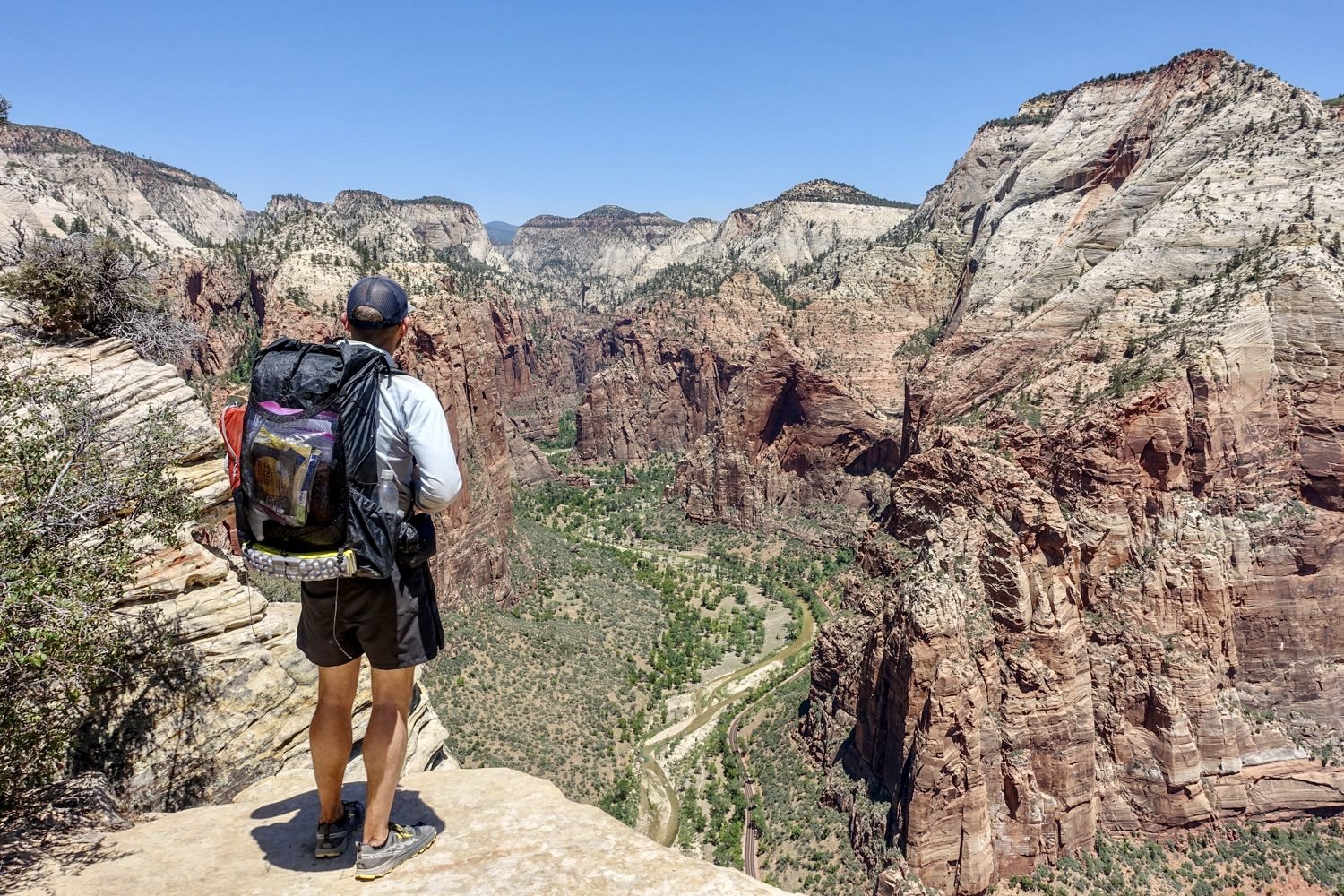
DURABILITY
Traditional backpackers usually expect their gear to perform well and hold up against the elements of nature without much worry. Being able to throw your bag in the back of a pickup when hitching into town or bushwacking through an overgrown trail can bring a lot of peace of mind to an adventure.
The most durable backpack we tested, the Osprey Aether, felt like a tank. Sporting 210D and 420D nylon construction, the only weak spots were the mesh side pockets. Close behind is the thru-hiking wonder, the ULA Circuit. With strong Robic 400 nylon for the entirety of its construction, it even beats the Aether in some regards since it doesn’t use mesh for its water bottle pockets, making it even better for bushwhacking.
Other notable performers were the Osprey Atmos, Gregory Baltoro, REI Trailmade, and Granite Gear Crown 3. These used mesh sparingly, had overall decent fabric choices, and excellent stitching that should hold up to use well.
On the slightly lower end, we thought the Osprey Exos, REI Flash 55, and Deuter Aircontact Ultra used a bit too much mesh for our liking, or thinner materials that didn’t give us as much confidence as our higher-scoring picks. All should stand up to a thru hike with proper care.
In a distant last place, the Nevo Rhino had terrible stitching quality and questionable fabric choices, which meant we don’t have much confidence in it lasting a long time of use.
EASE OF USE
In general, we found little to complain about when it came to these packs. Most of them were straightforward. Although with more fully featured packs, all the features start to become a bit overwhelming. For this reason, we ranked more straightforward packs a little higher than full-featured packs.
The pack we feel executed well on nearly every feature is the ULA Circuit. Sporting a very focused design, it nevertheless includes many helpful features to support a thru-hiking goal, and at the end of the day, it is the pack that we thought the least about during testing.
Close behind are two of our favorite packs, the Gregory Paragon and the delightful REI Trailmade. The Paragon strikes the best balance of giving enough features to be helpful without being overwhelming. The Trailmade follows a similar trend to the Circuit. We especially love the easy-to-access water bottle pockets. Speaking of great water bottle access, we have to give a special shout out to the best water bottle solution in the lineup. The burly Gregory Baltoro wins this hands down with its clever stowable side holster. Placing the bottle lower than any other pack on our list, it is so easy to access that we immediately wished that Gregory’s other pack, the Paragon, had this feature.
Rounding out the middle of the group, the Osprey Aether, Osprey Atmos, Osprey Exos, and REI Flash all impress us with straightforward designs that didn’t frustrate us during testing. Slightly behind them, the Granite Gear Crown3 and Deuter Aircontact Ultra weren’t frustrating, but had a few more nitpicks than those above. And again in last place, the Nevo Rhino felt tedious to use after the streamlined designs of the rest of the pack.
How to Choose a Backpacking Backpack
COMFORT
At the end of the day, our best advice is to pick the most comfortable backpack. In general, more padding is better, but that can make airflow hard. Wider shoulder straps will distribute the load better as will taller hip belts. Suspended mesh backs or “trampoline” backs can hugely help with airflow and sweat mitigation but will also make a pack feel heavier by shifting the center of gravity backward.
If you’re lucky enough to live near a gear shop, get fitted and then try packs on with some weight. Do a bit of walking, jumping, and moving around. Pay attention to the upper parts of your hip bones (the iliac crest); those are the parts that will bear the most weight. Feel your collarbone area – those can also form pressure points. Tighten down the pack and then loosen things up to see how that feels. When you’ve done that with each pack, pick the one that’s most comfortable.
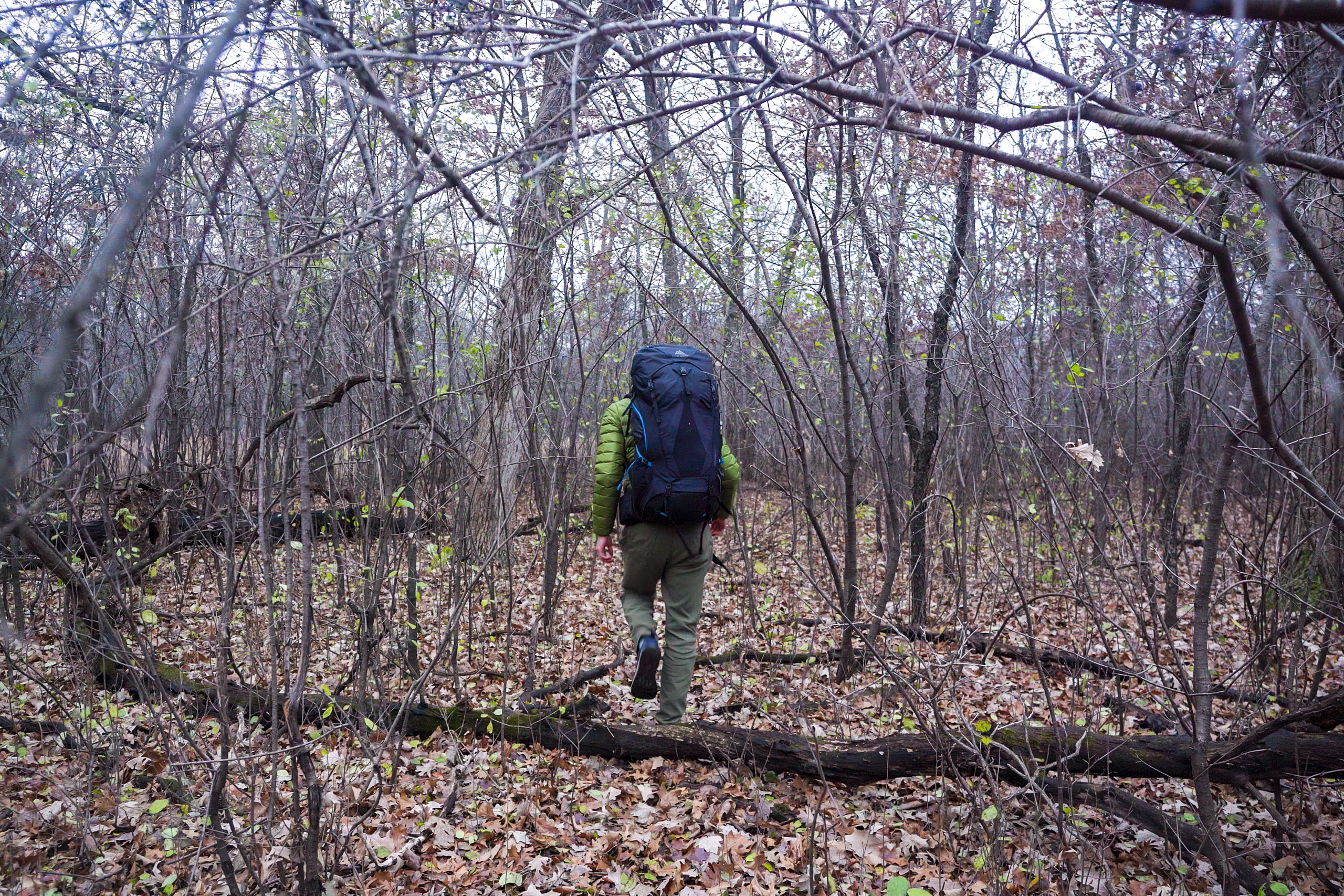
CAPACITY
Most traditional backpackers enjoy a pack size of 60 liters. That gives enough capacity for a week-long trip while carrying some luxuries, but also isn’t so big that it would be cumbersome for a weekend adventure. For more experienced people who are trying to shed weight, 45L is around the lower limit before you start getting into ultralight territory. Conversely, for expeditions consistently a week plus, or for people who have more specialized requirements in the backcountry, a pack of 70 liters or more is appreciated.
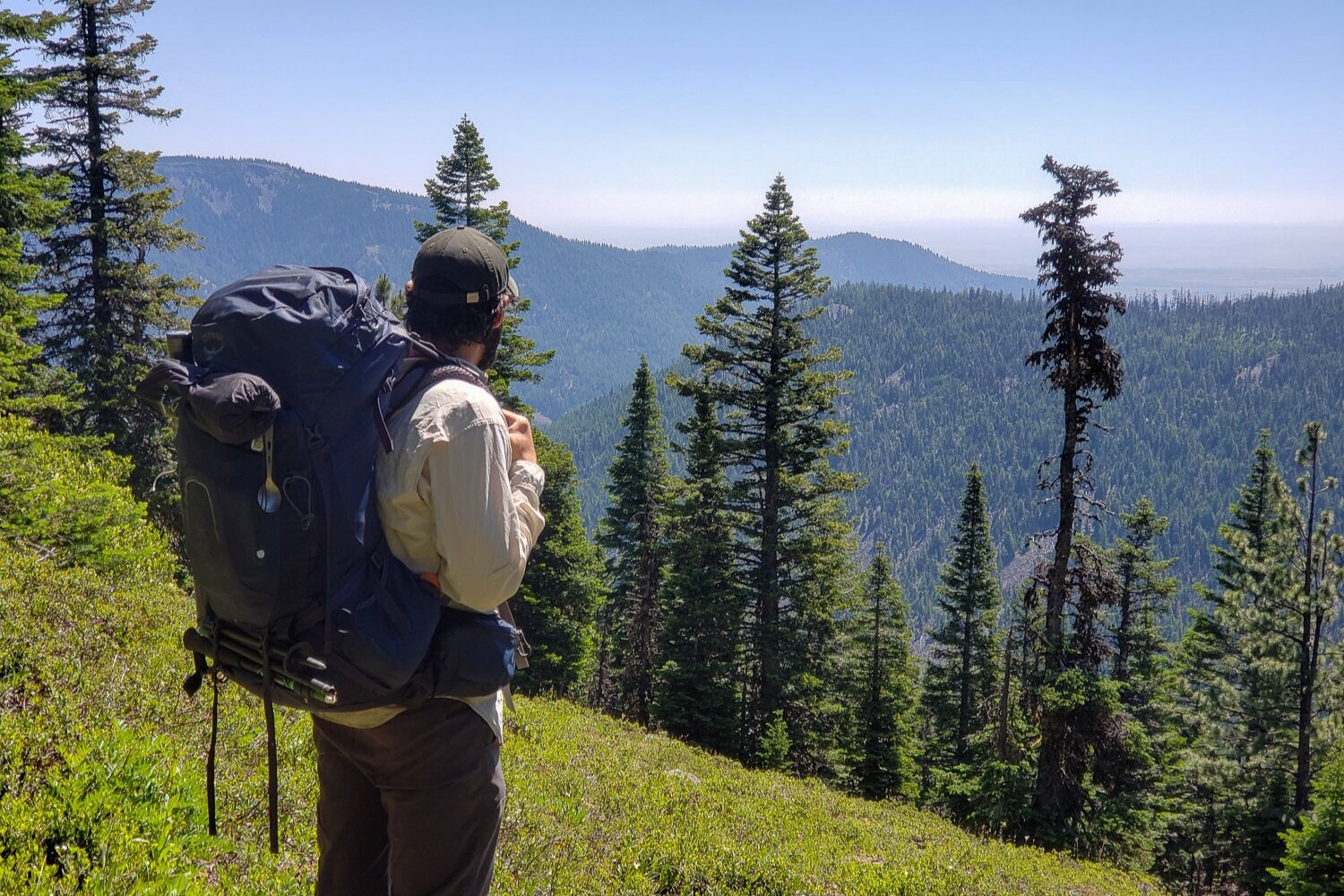
FEATURES
There are a dizzying array of features offered by backpack manufacturers. Everyone has their own preferences, but we’ll point out our favorites. Comfortable water bottle pockets are a must, since they’re the ones you’ll be accessing most often – try on a pack and make sure you can reach them easily. A back stretch pocket is great for stashing quick items like a raincoat, trowel, or sit pad. We also appreciate large and easy to use hipbelt pockets, with smooth zippers and solid face fabric for durability. If you’re still finding your ideal fit, a pack with an adjustable torso length will help. If you know you sweat, a back panel with airflow or a suspended mesh can do wonders for comfort.
Depending on the regulations of where you backpack, it’s a good idea to make sure your pack fits a bear can. We prefer fitting horizontally inside, but a Y strap over the top is good as well. Some packs offer women-specific models. From our research, most manufacturers are trying to offer comfort improvements that should appeal more to the average woman rather than just a color change.
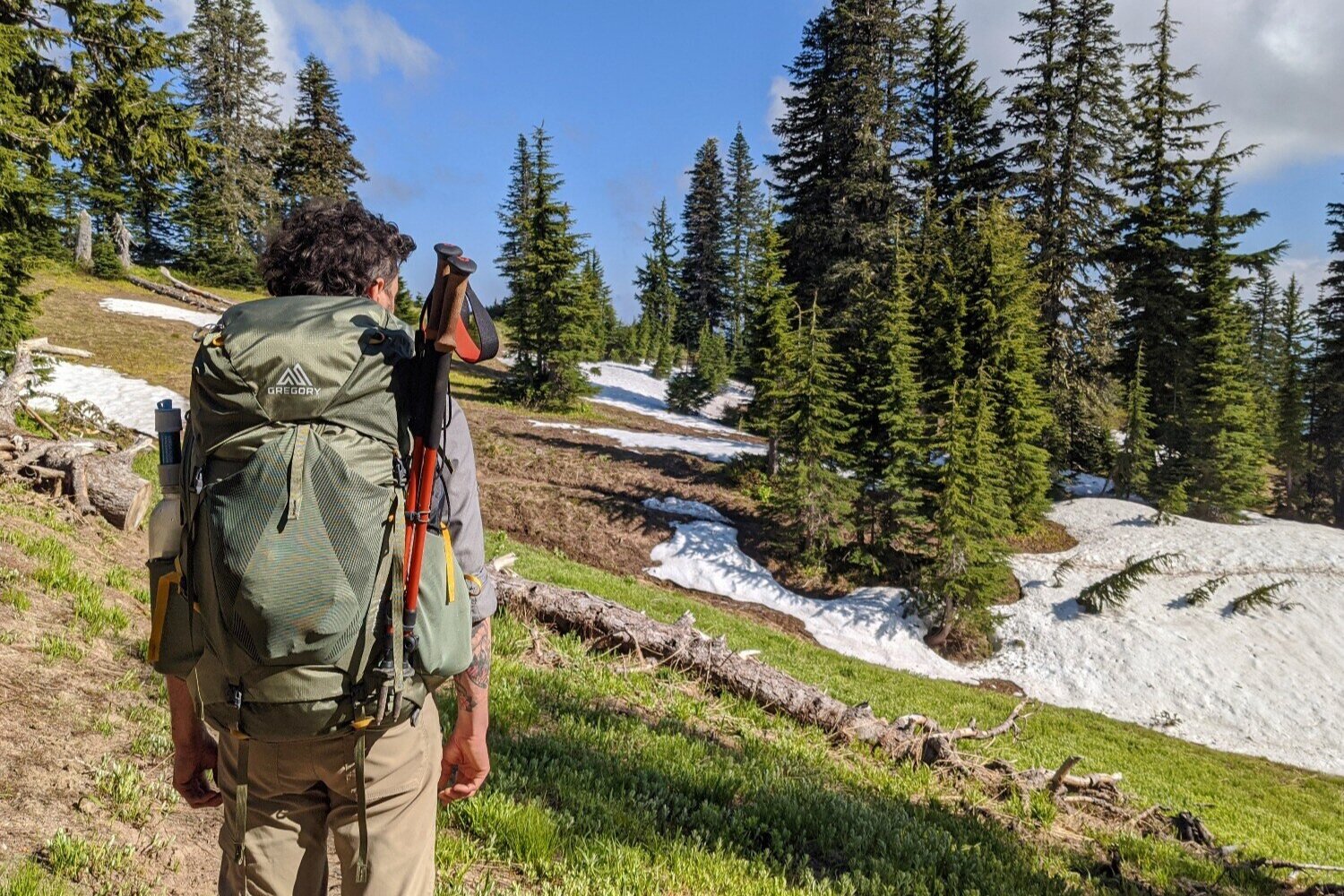
DURABILITY
The most durable packs are made of thick, high-quality fabrics and feature quality stitching. Avoiding fragile fabrics like mesh wherever possible will help longevity, and sections that will experience a lot of wear – like the bottom – should have thicker fabrics. Although long-term testing is always the best way to evaluate this, pack durability usually can be evaluated in person by assessing how solid the pack feels.
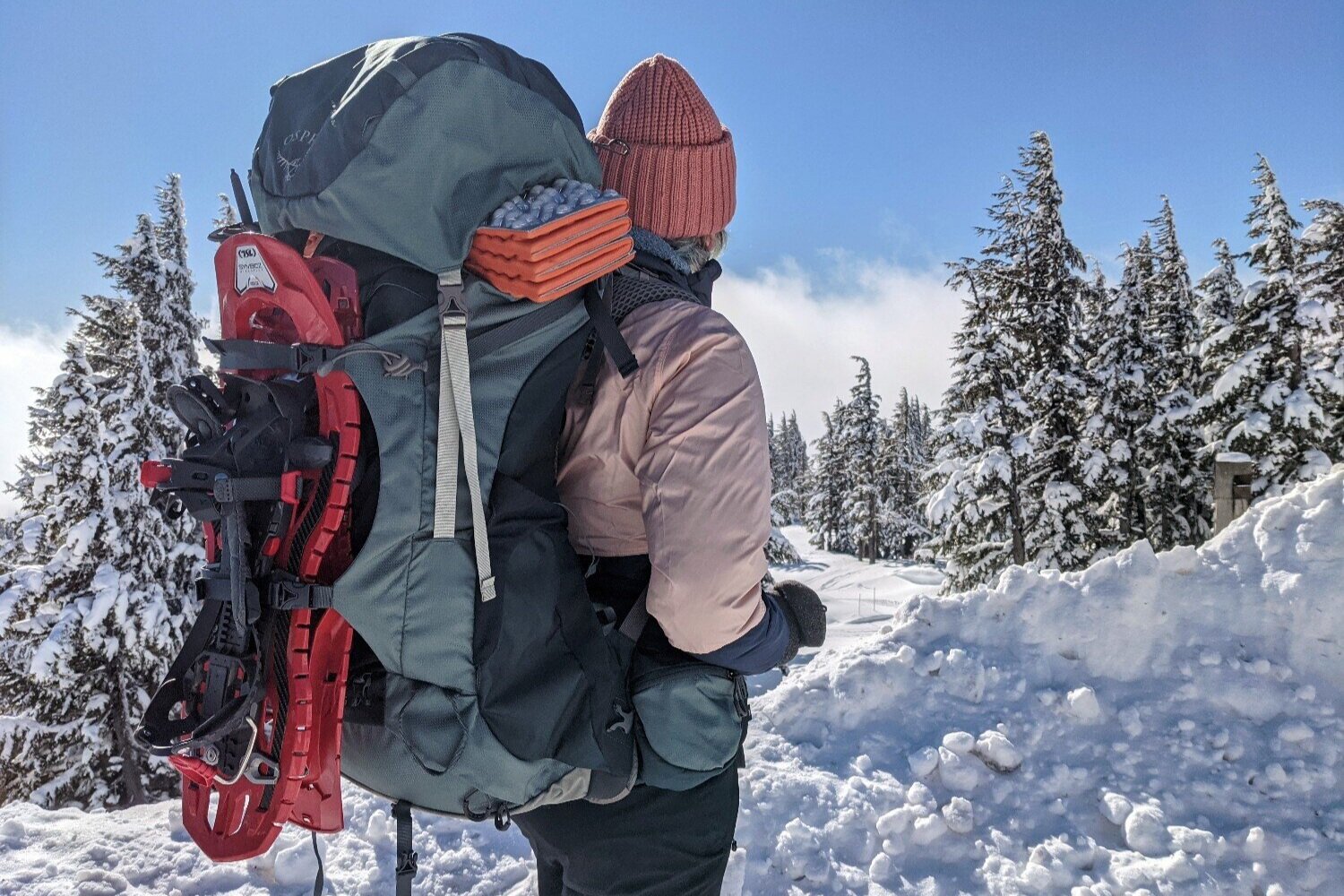
WEIGHT
The weight of a backpack can contribute significantly towards total carried weight. There’s a trend towards ultralight backpacking on long-distance trails, and it’s worth noting that the majority of the CleverHiker team uses ultralight gear.
Ultralight backpacks can be a quarter the weight of traditional packs, and when paired with lightweight gear, enable total pack weights under 20 pounds. However, ultralight packs often feel heavier than regular backpacks due to their minimal suspensions, especially if you haven’t already invested in ultralight gear. Plus, they wear out faster without appropriate care. When picking a backpack, look for the lightest pack that has the features and durability you want and can comfortably carry the weight and the bulk of the gear you’ll be hauling.
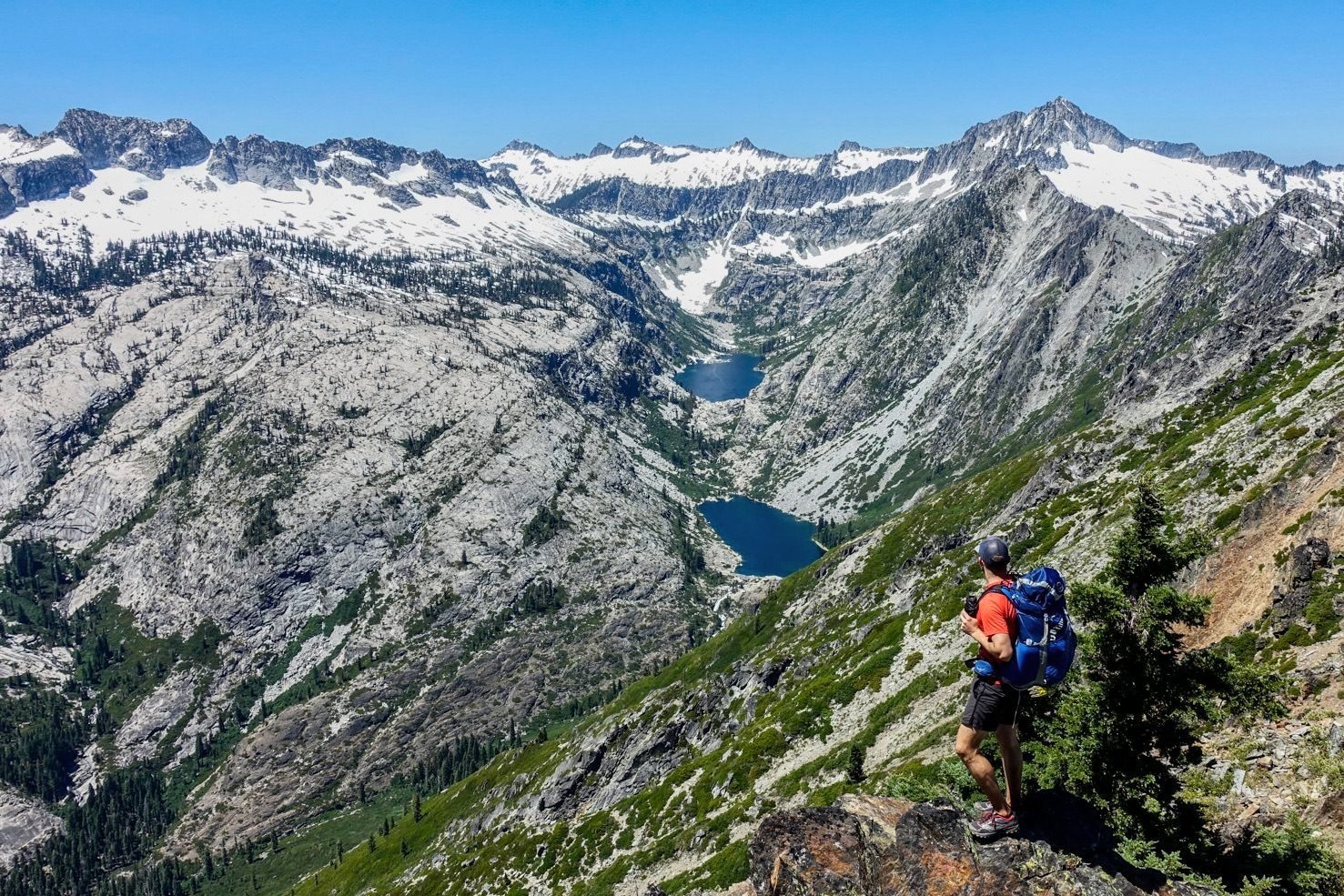
Conclusion
A backpack is one of the most personal items you’ll buy for an adventure, with comfort, weight, and feature preferences varying considerably from person to person. Whether you’re looking to tackle a multi-month journey or a fun overnight at a local park, we’ve got picks for every adventure. The most important thing is to get out and hike!
